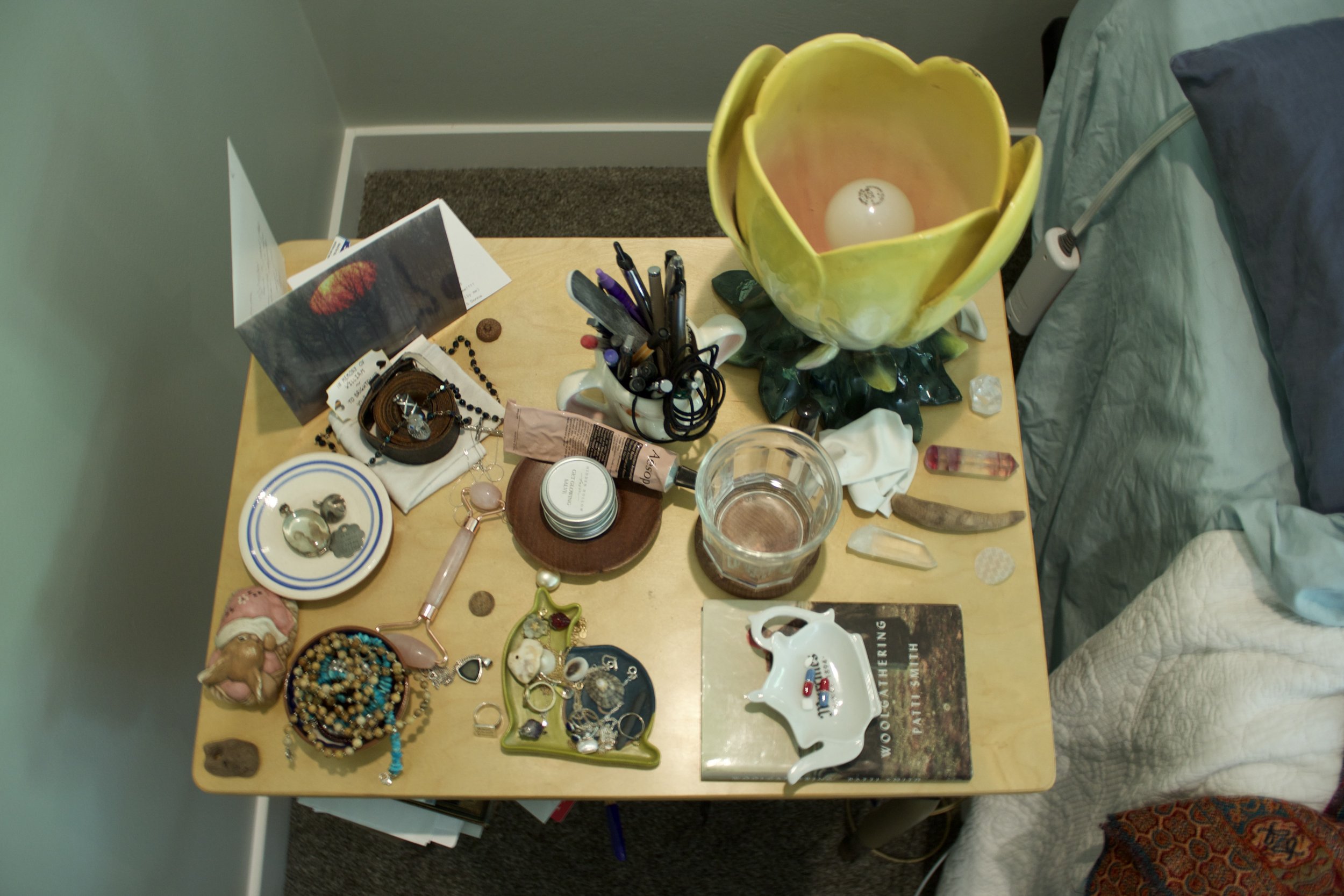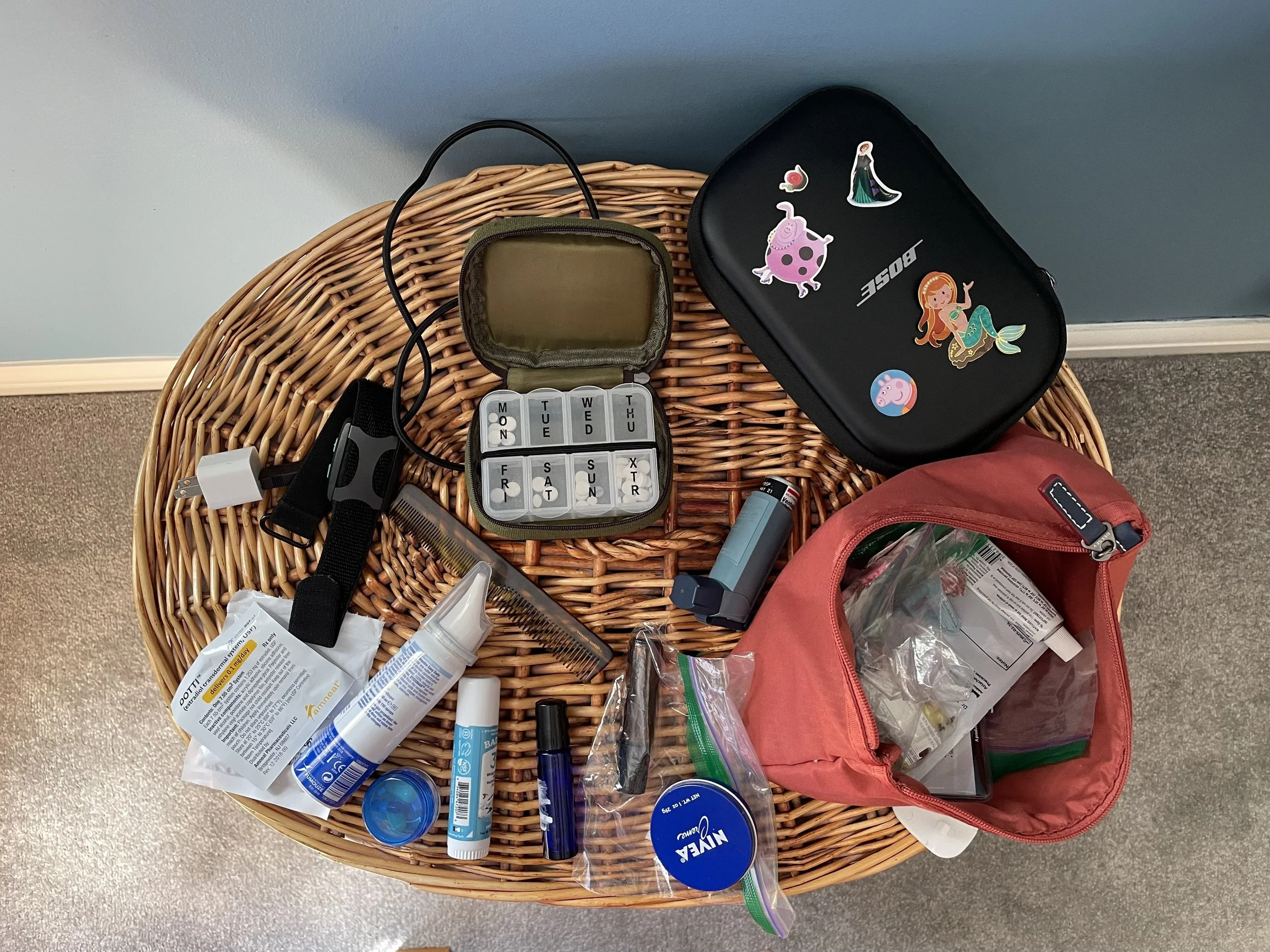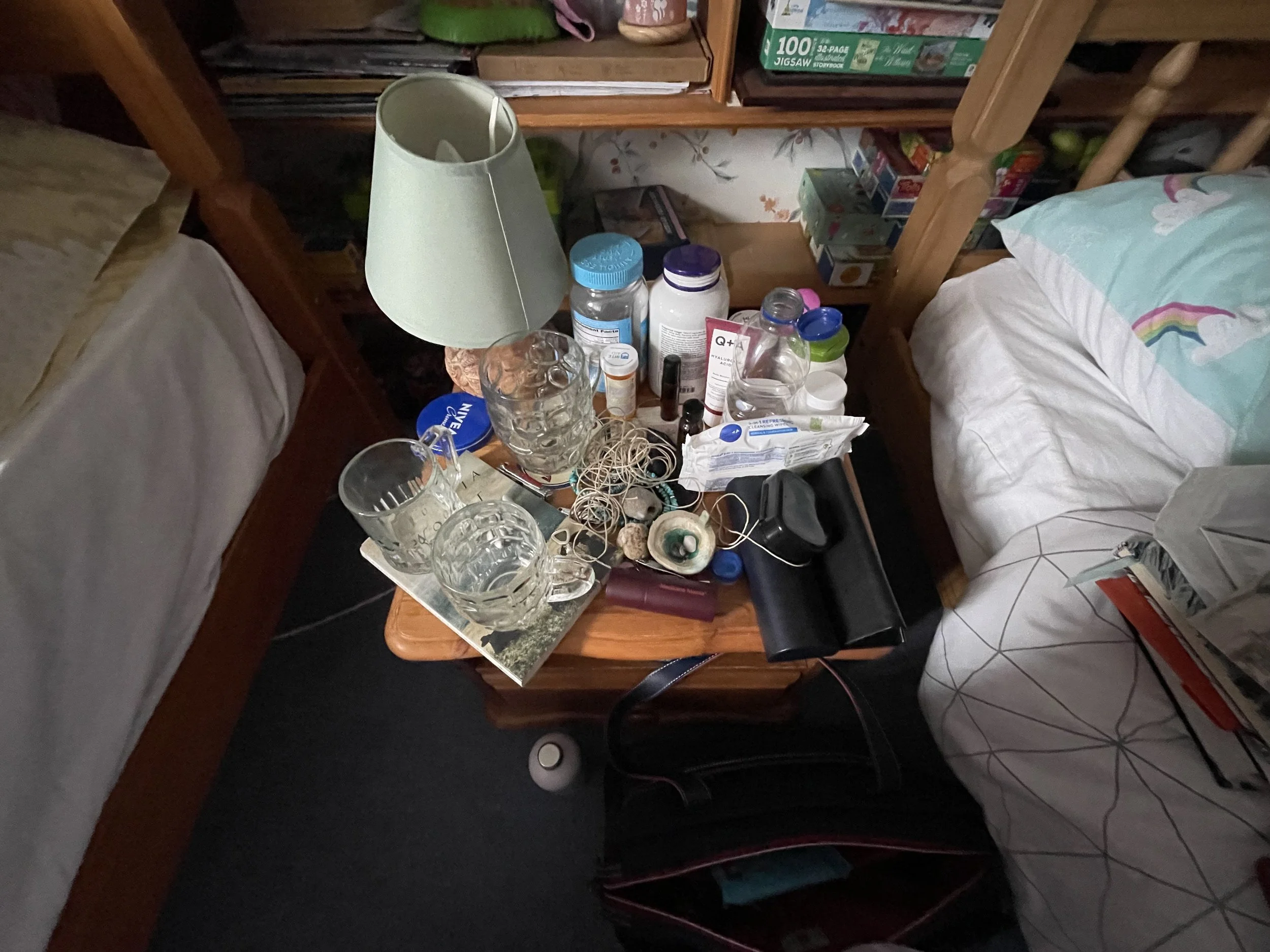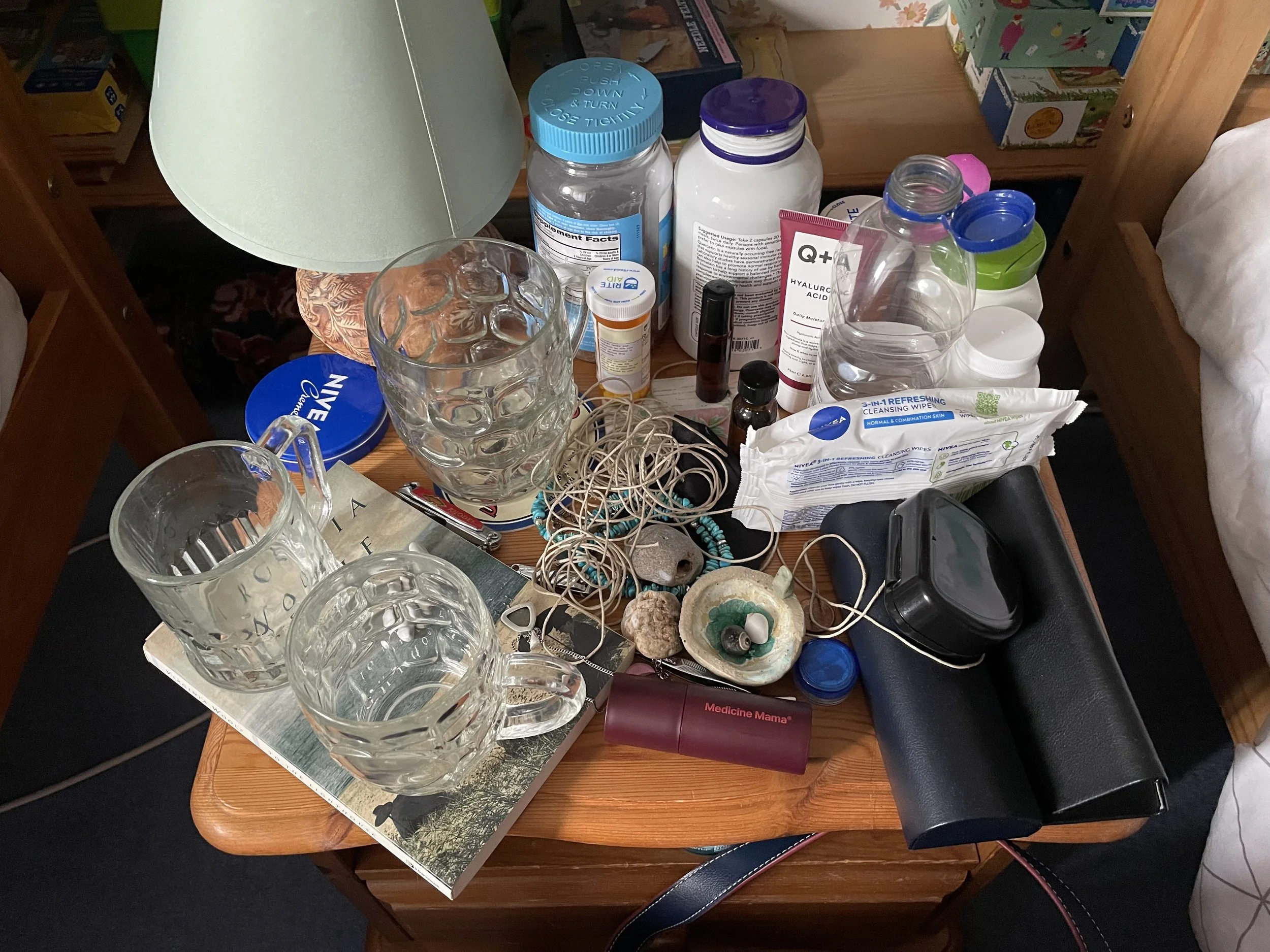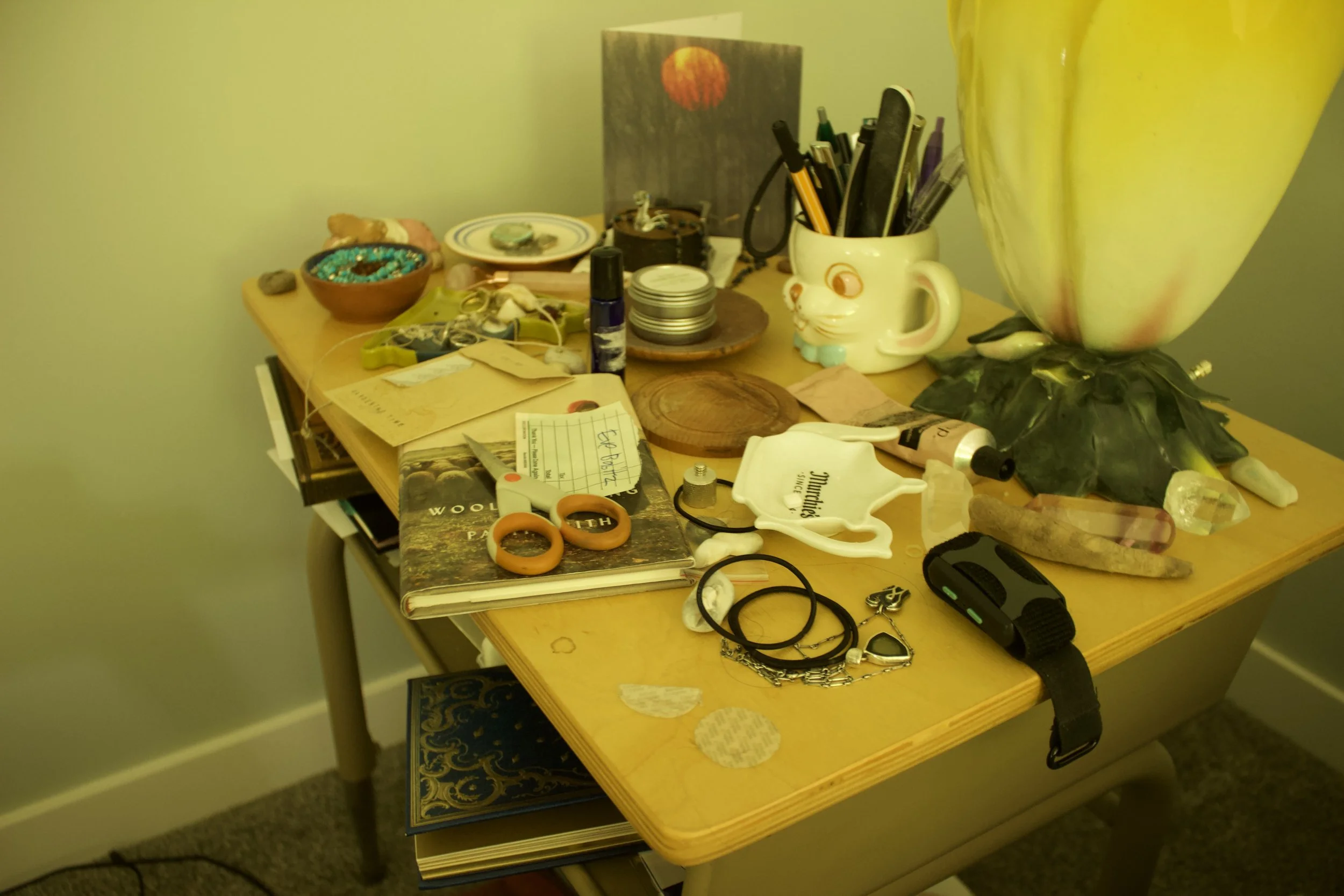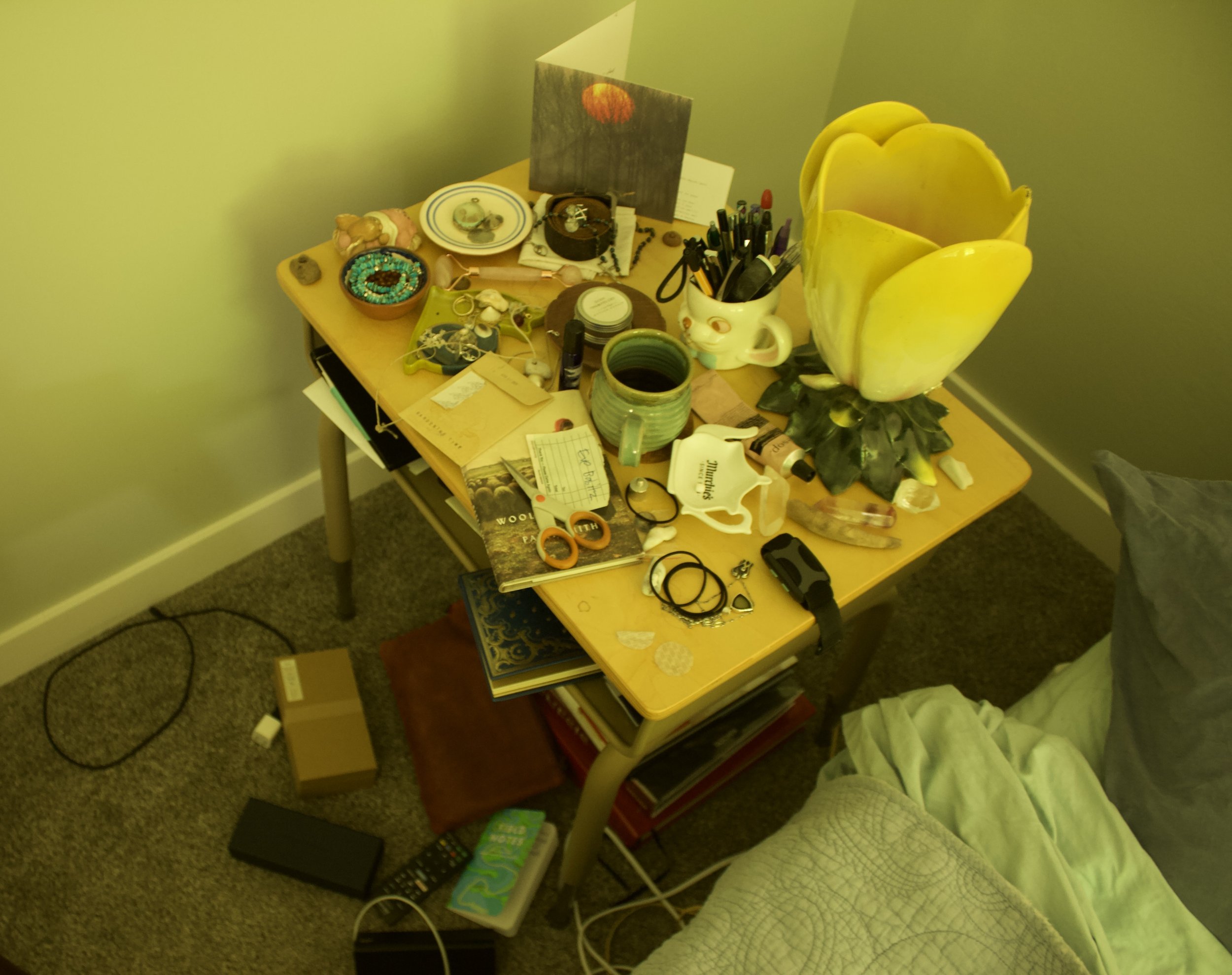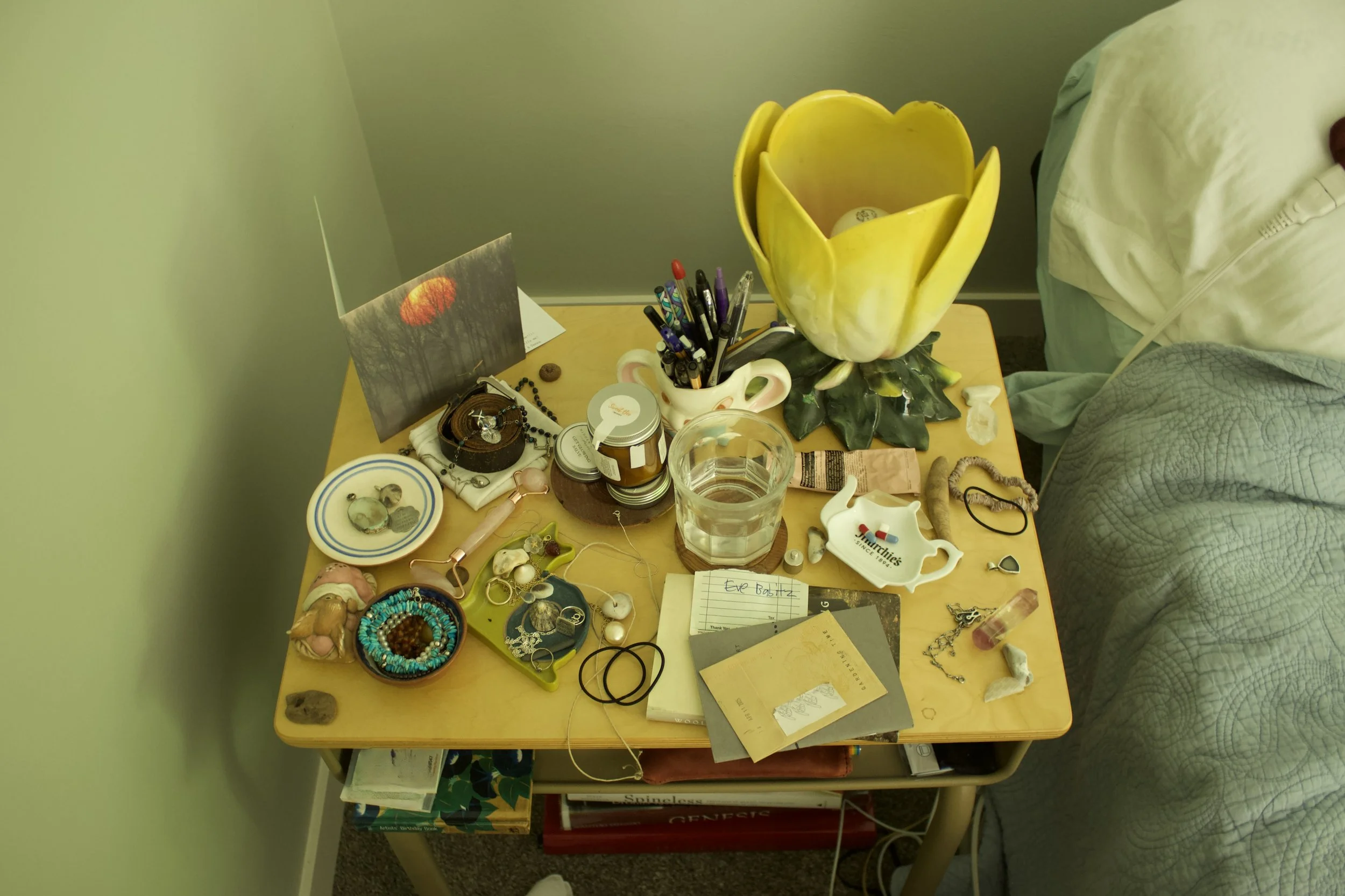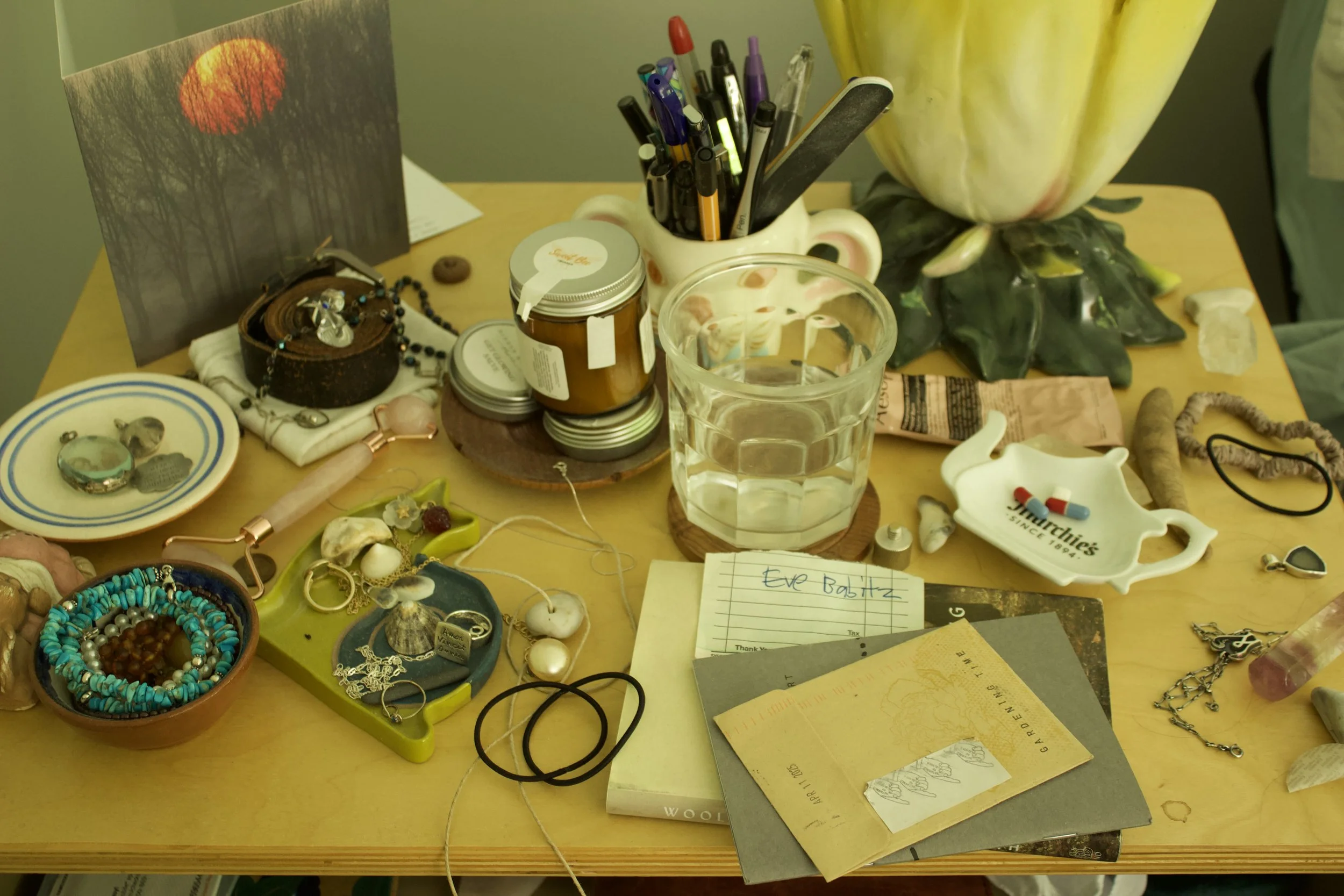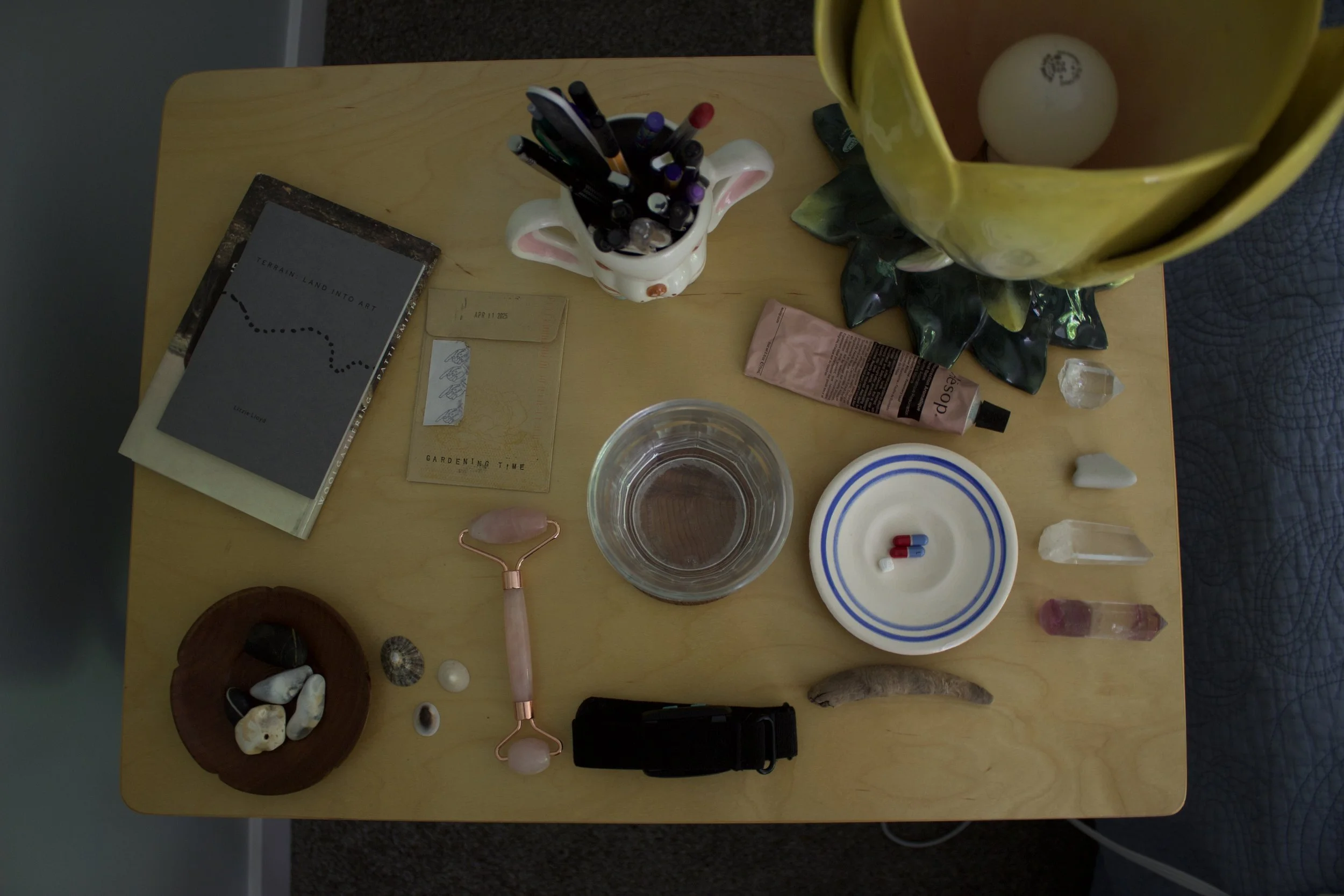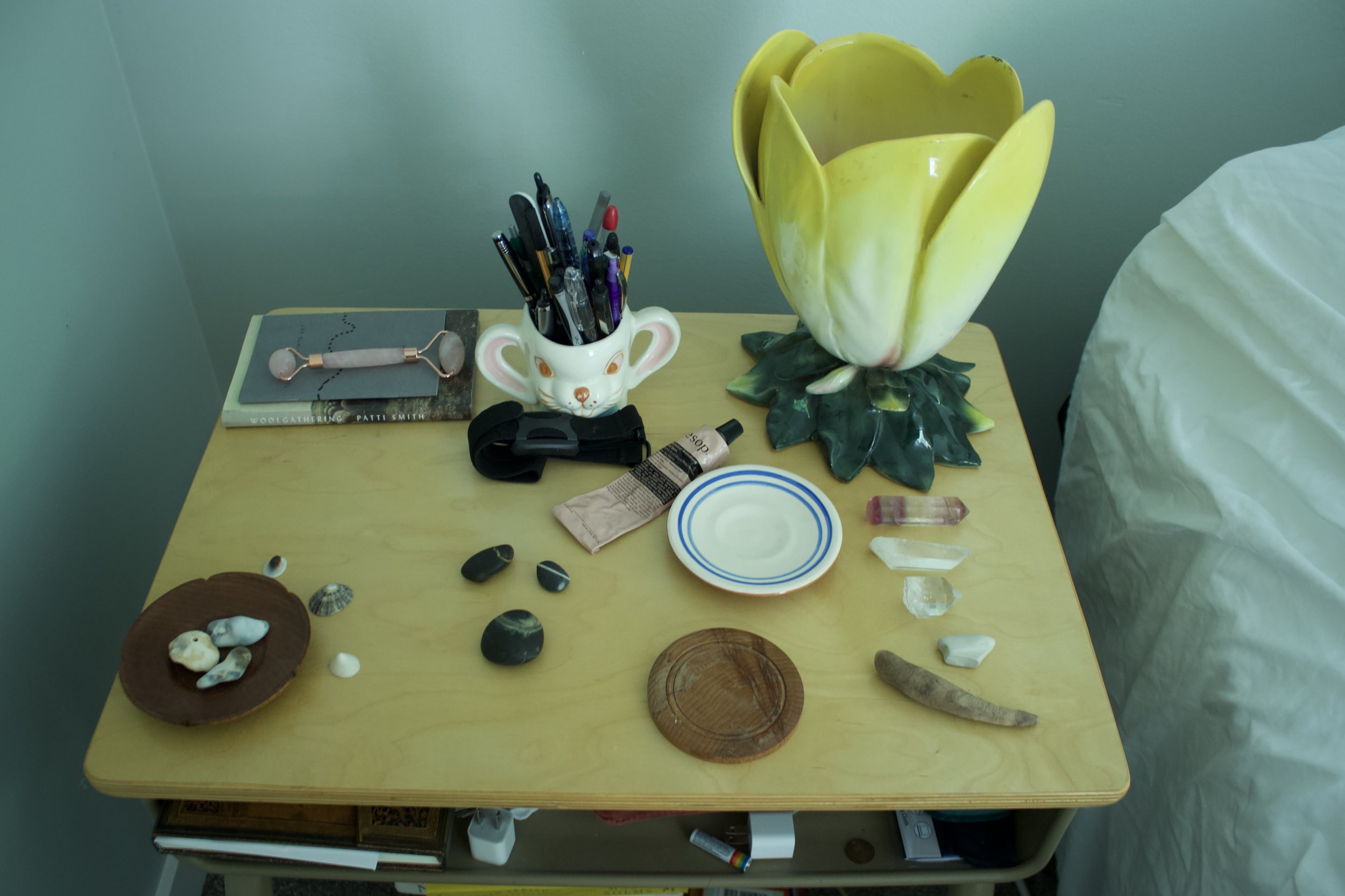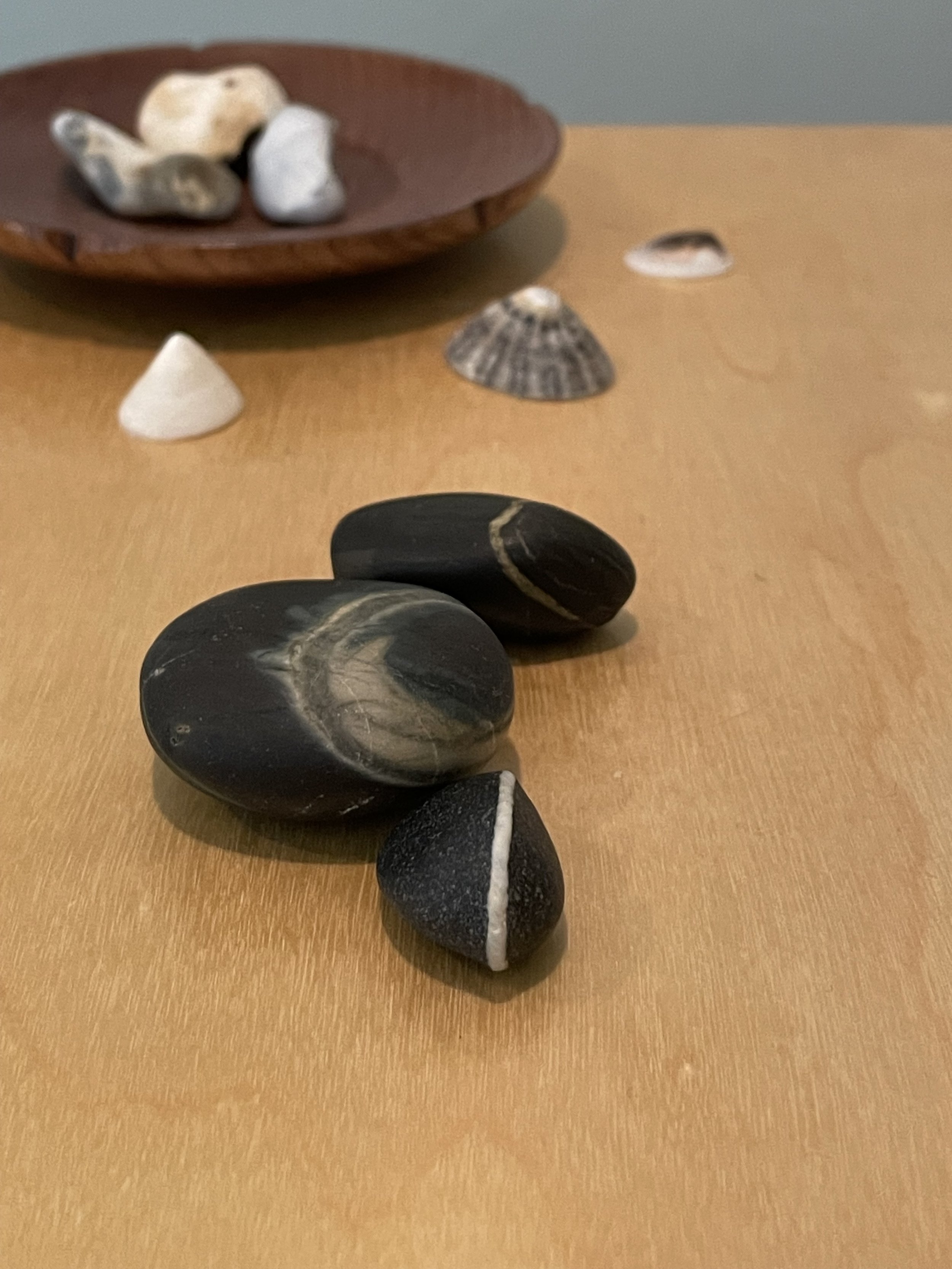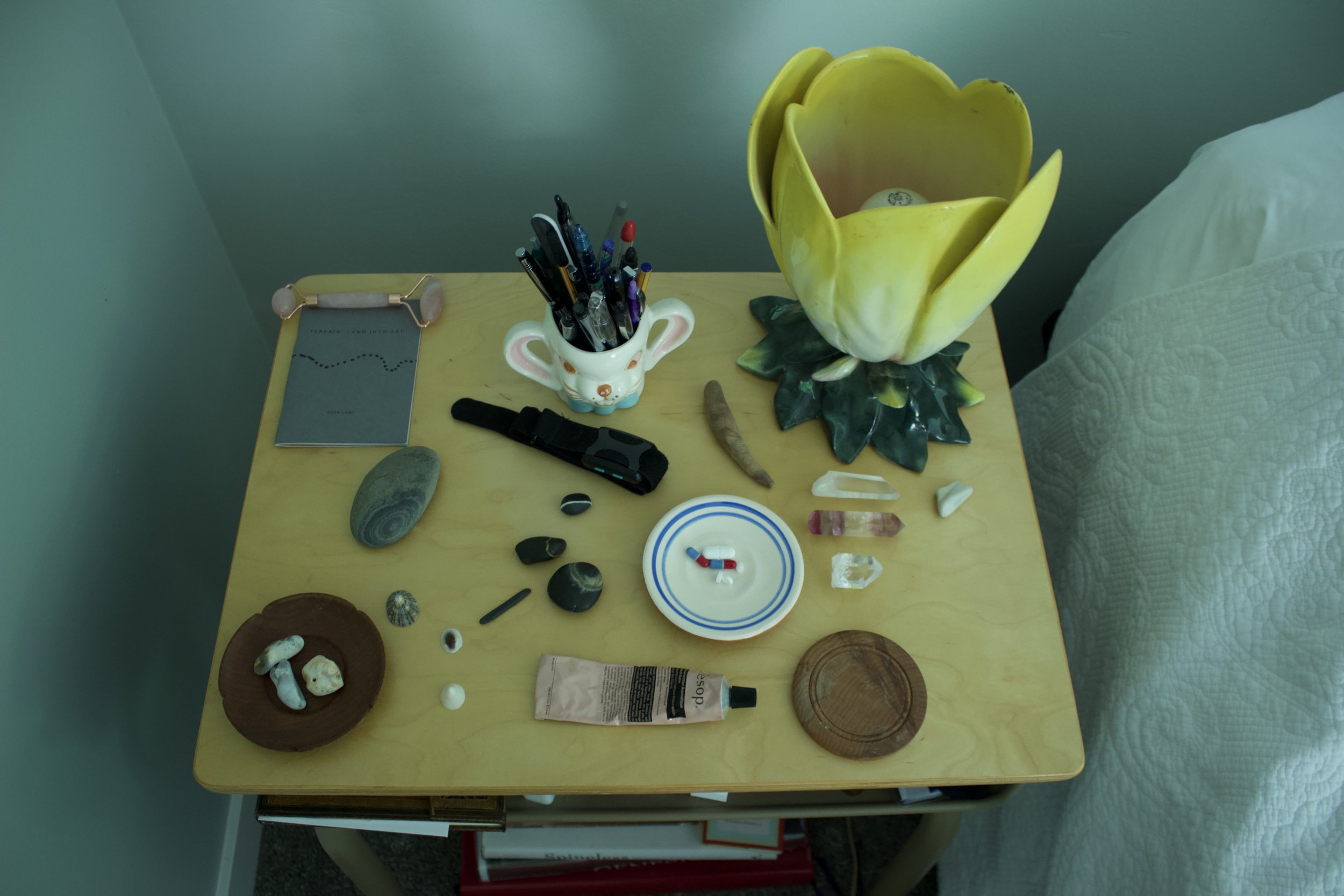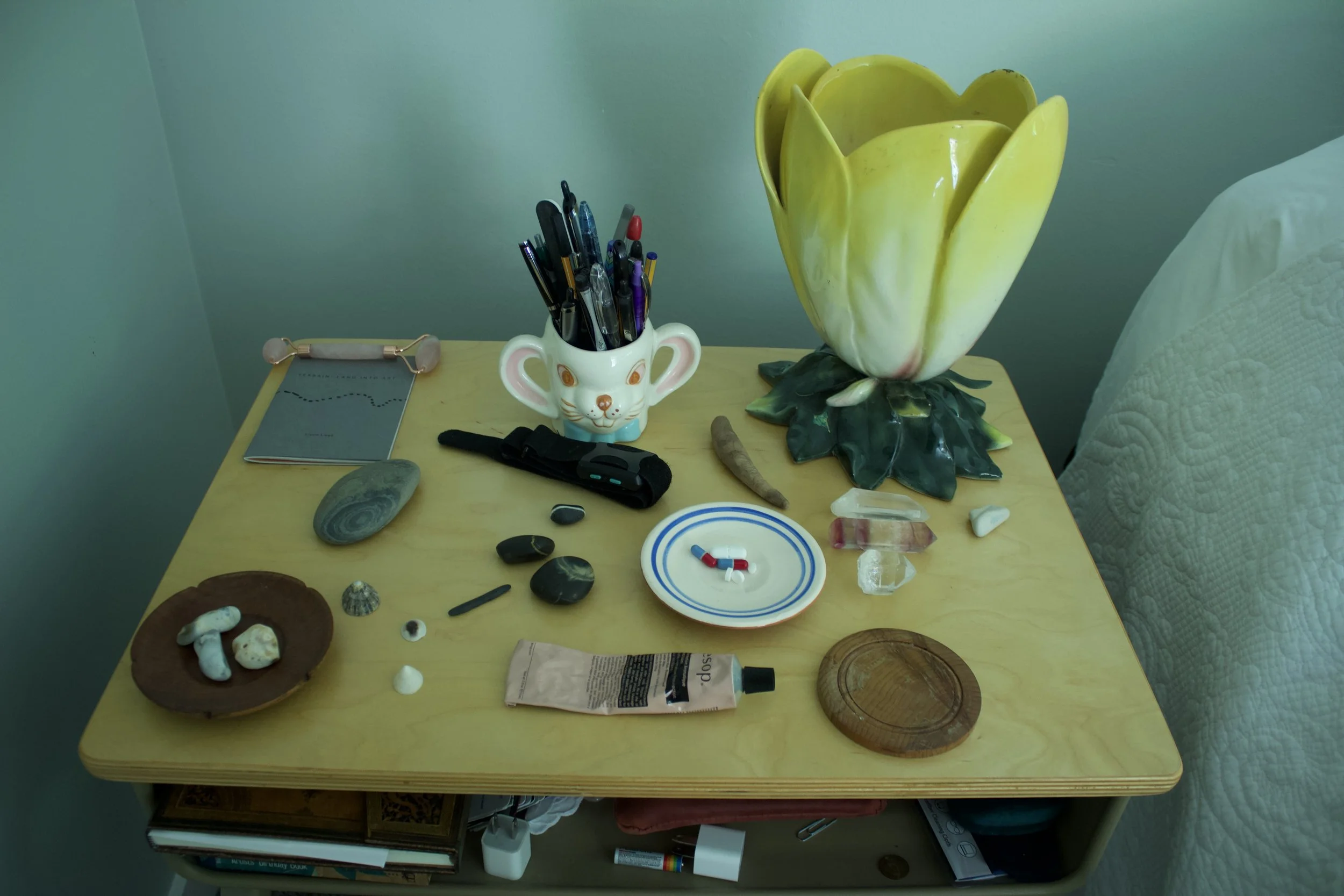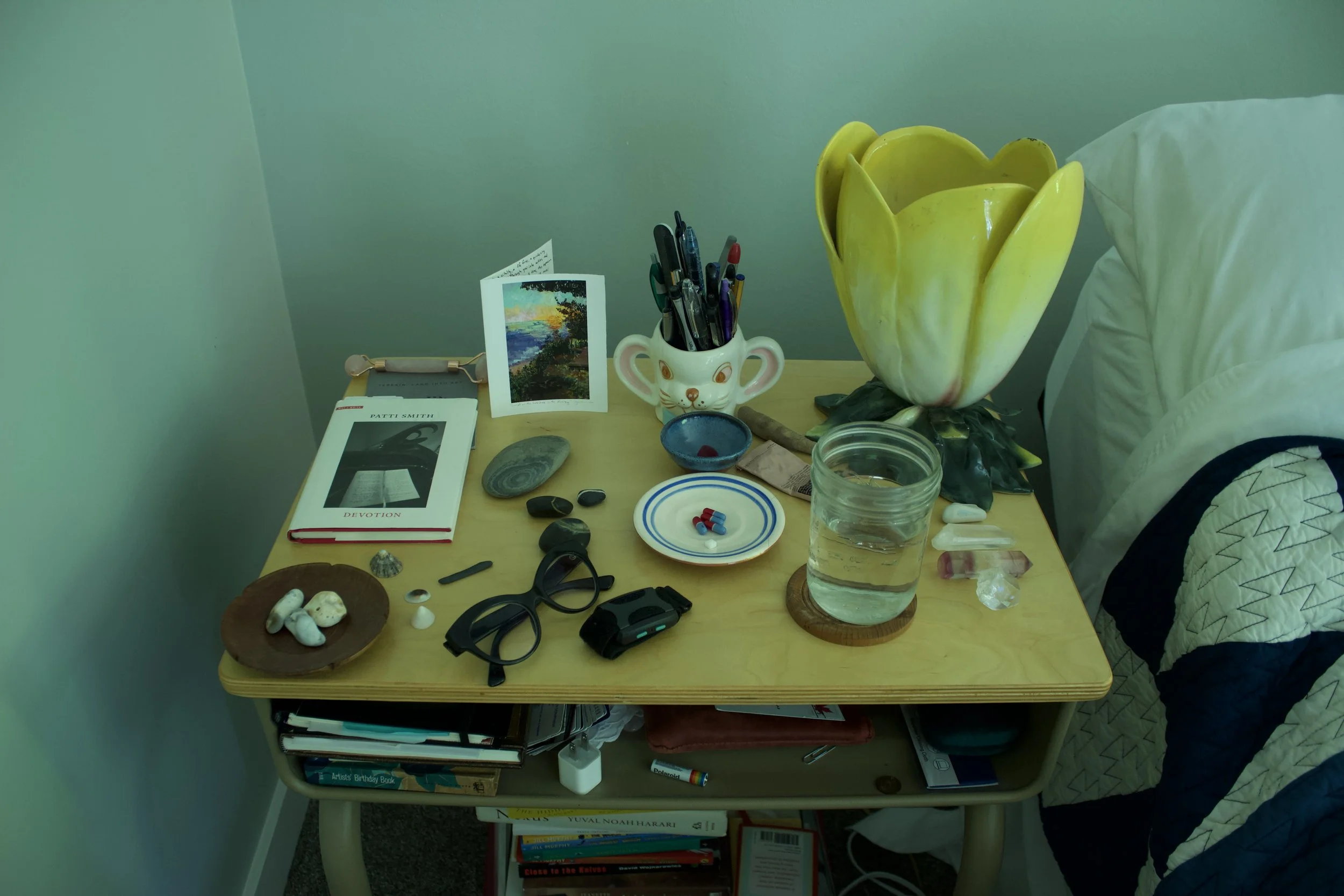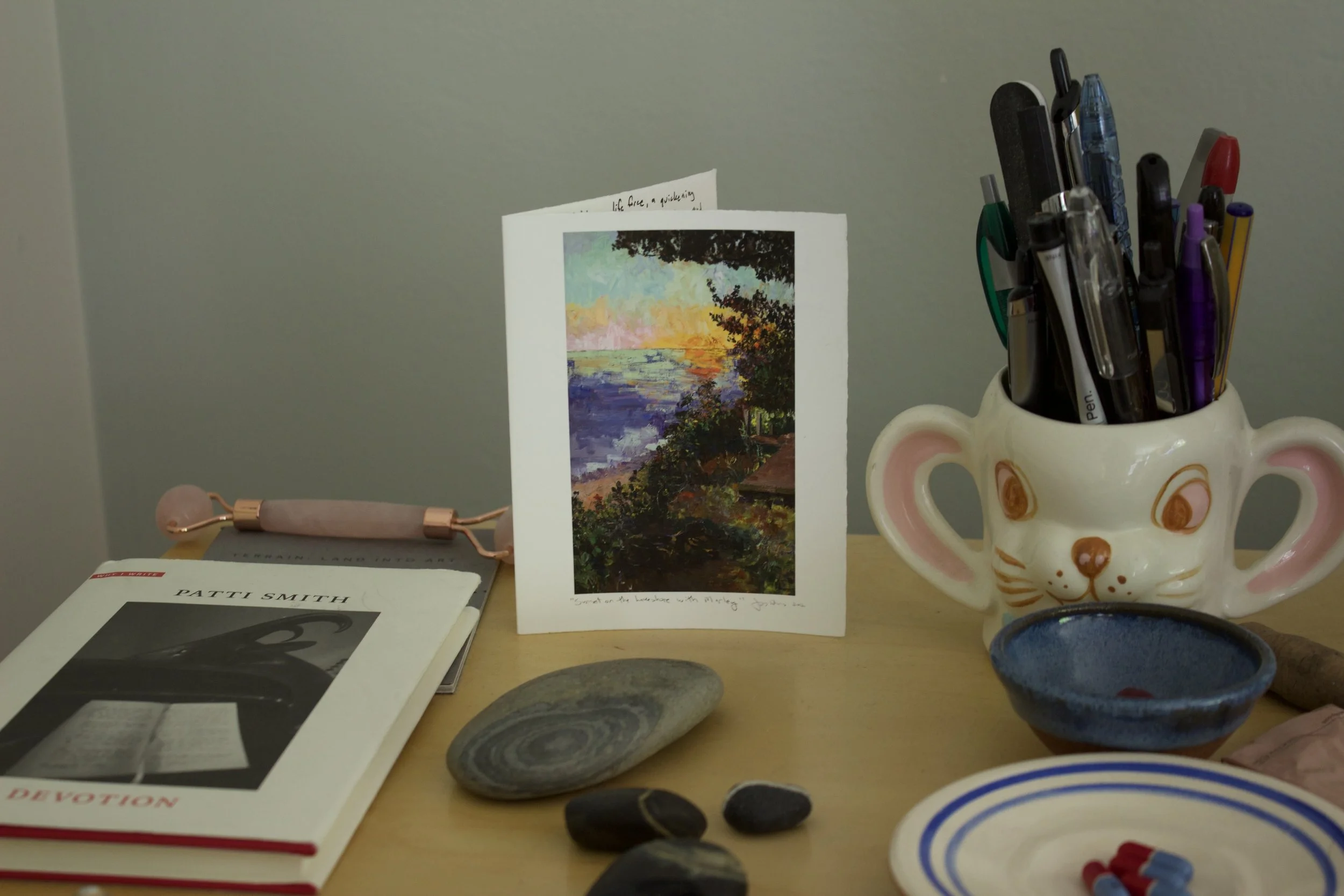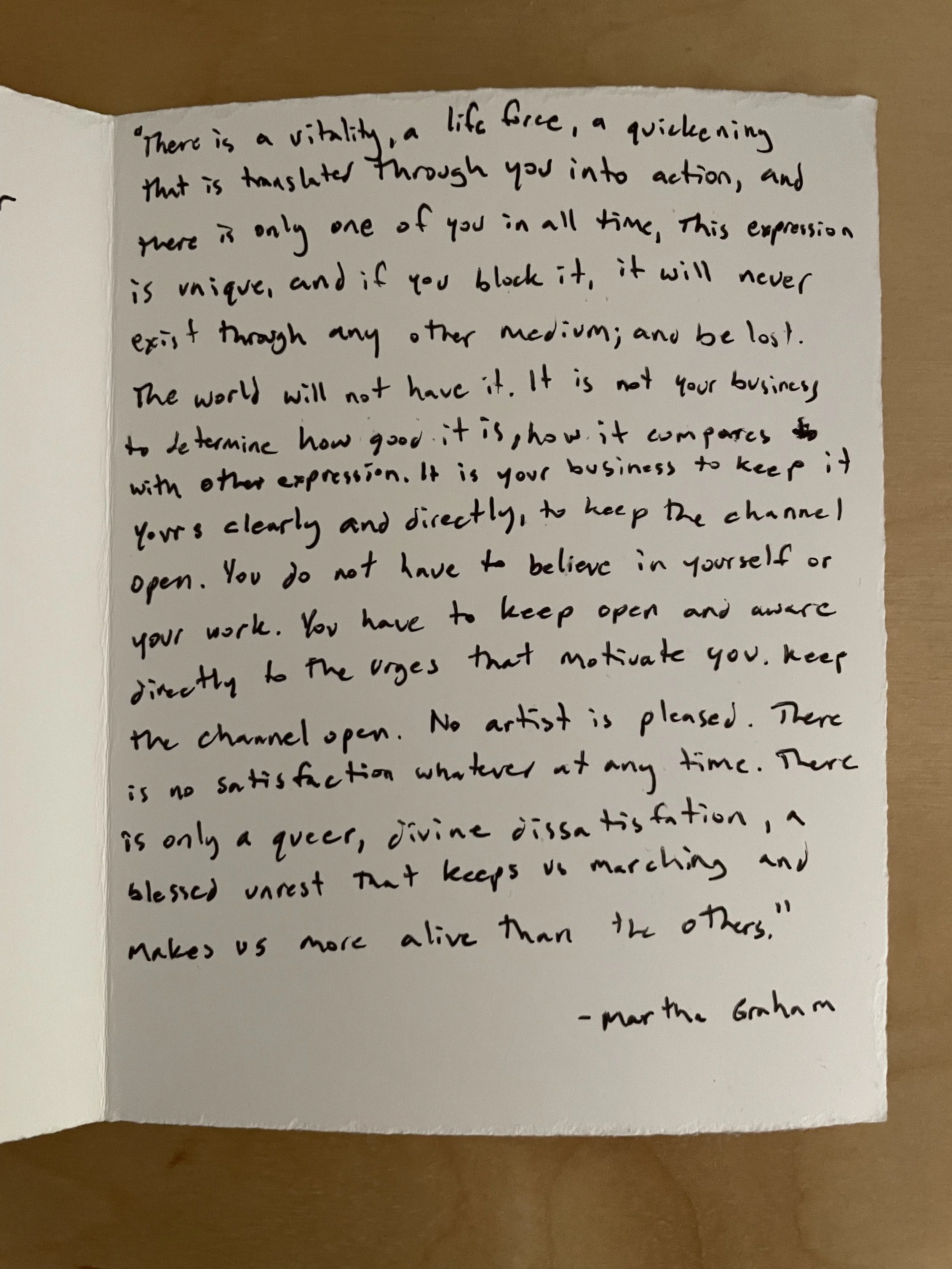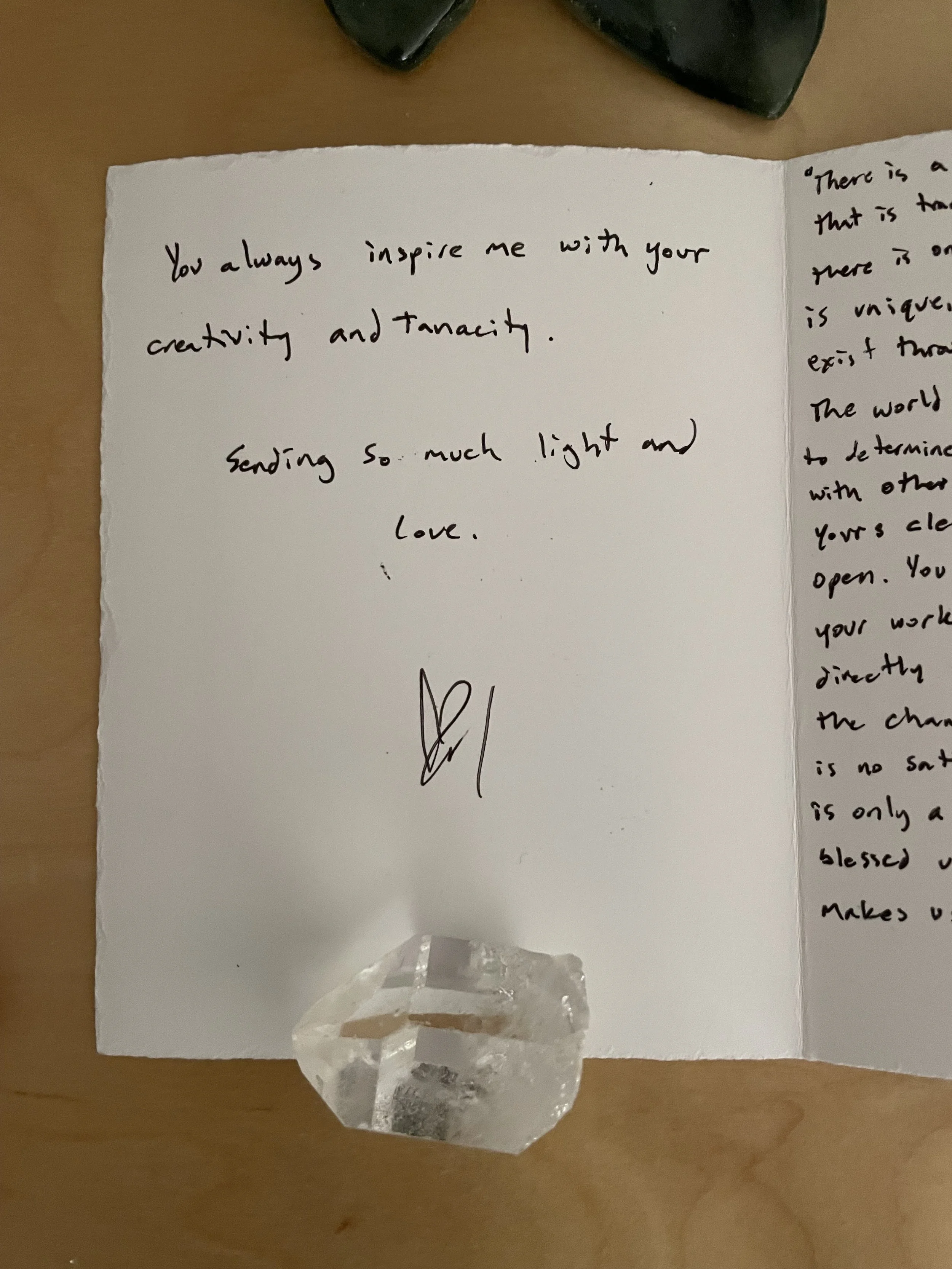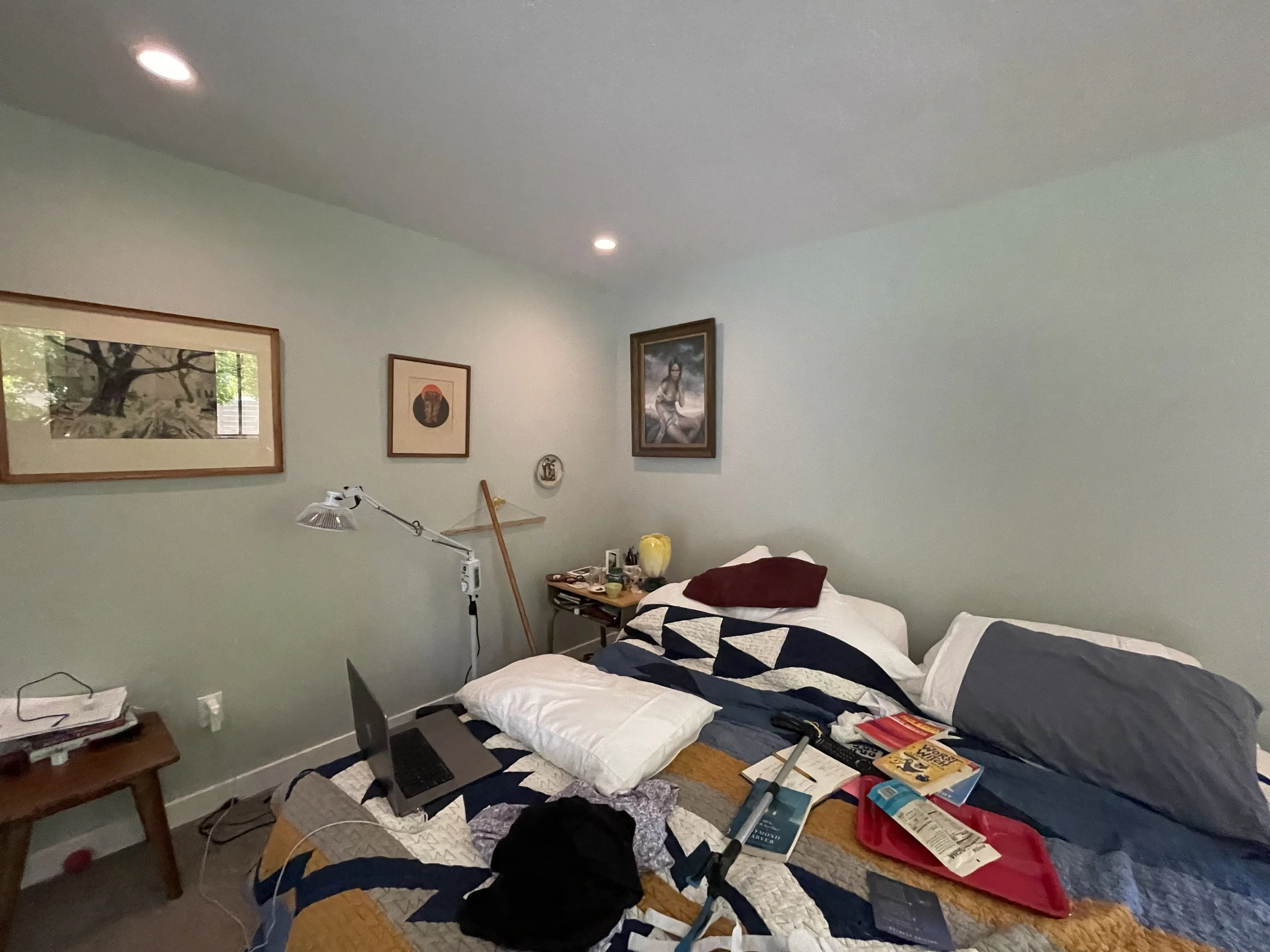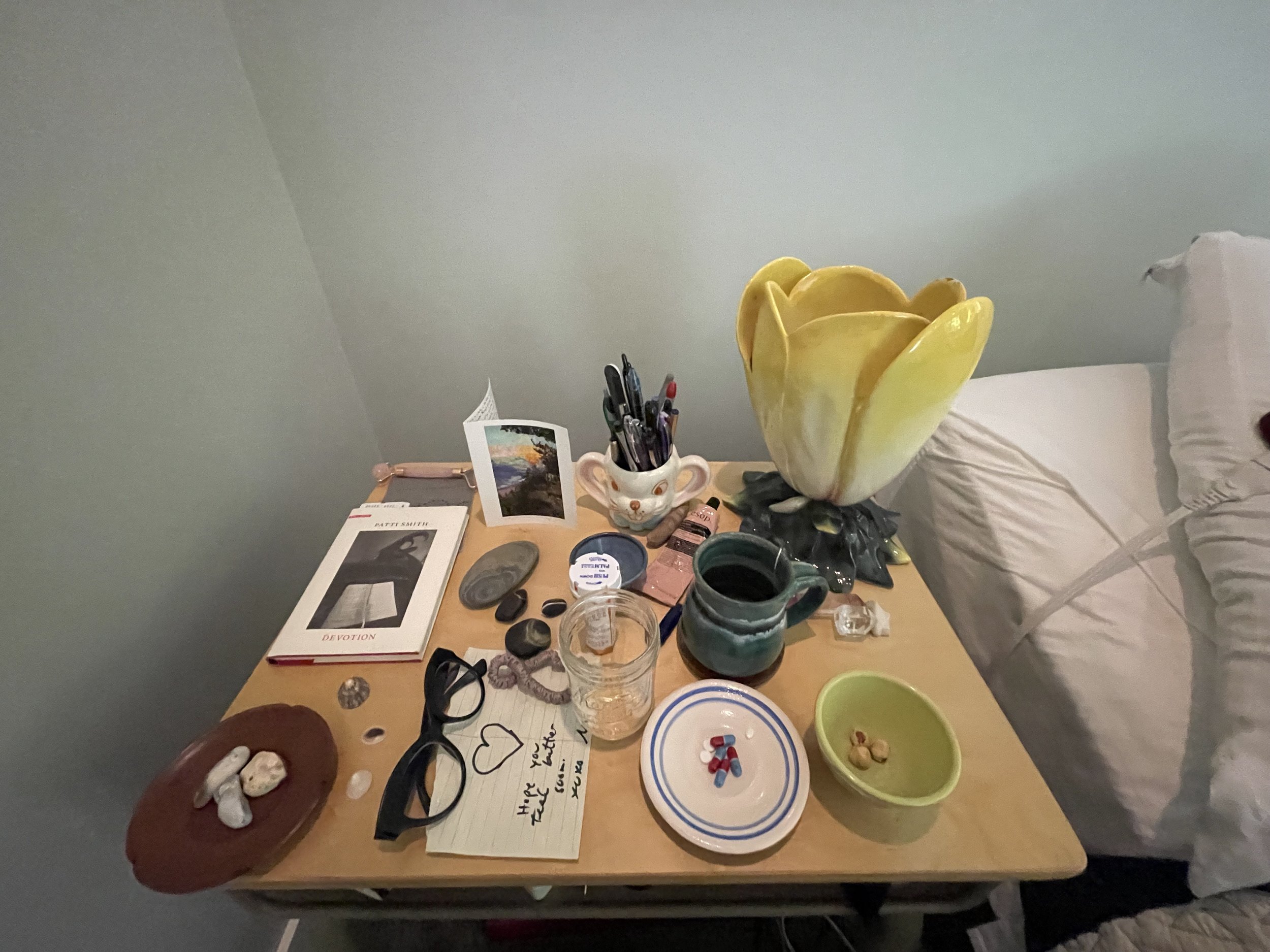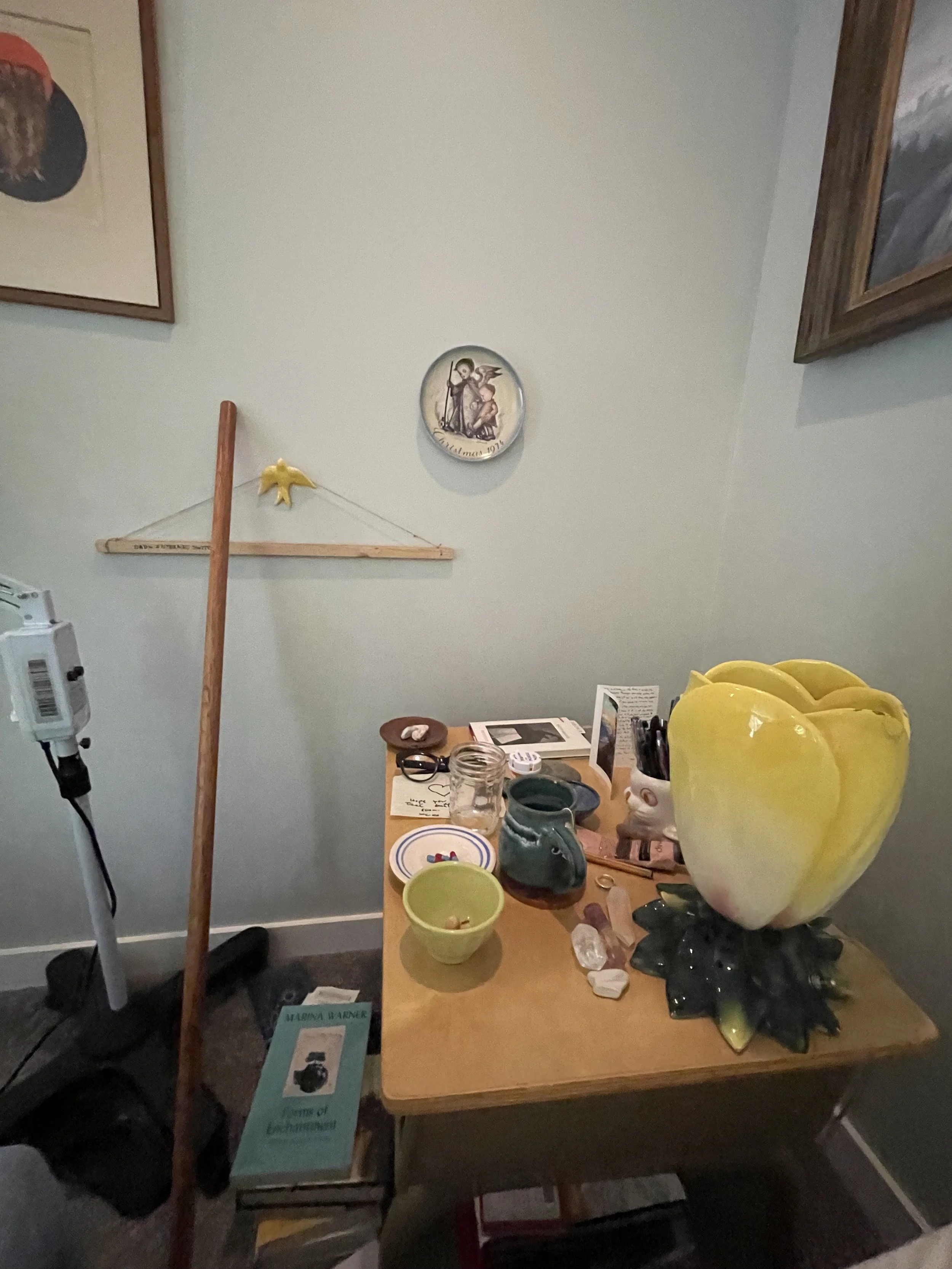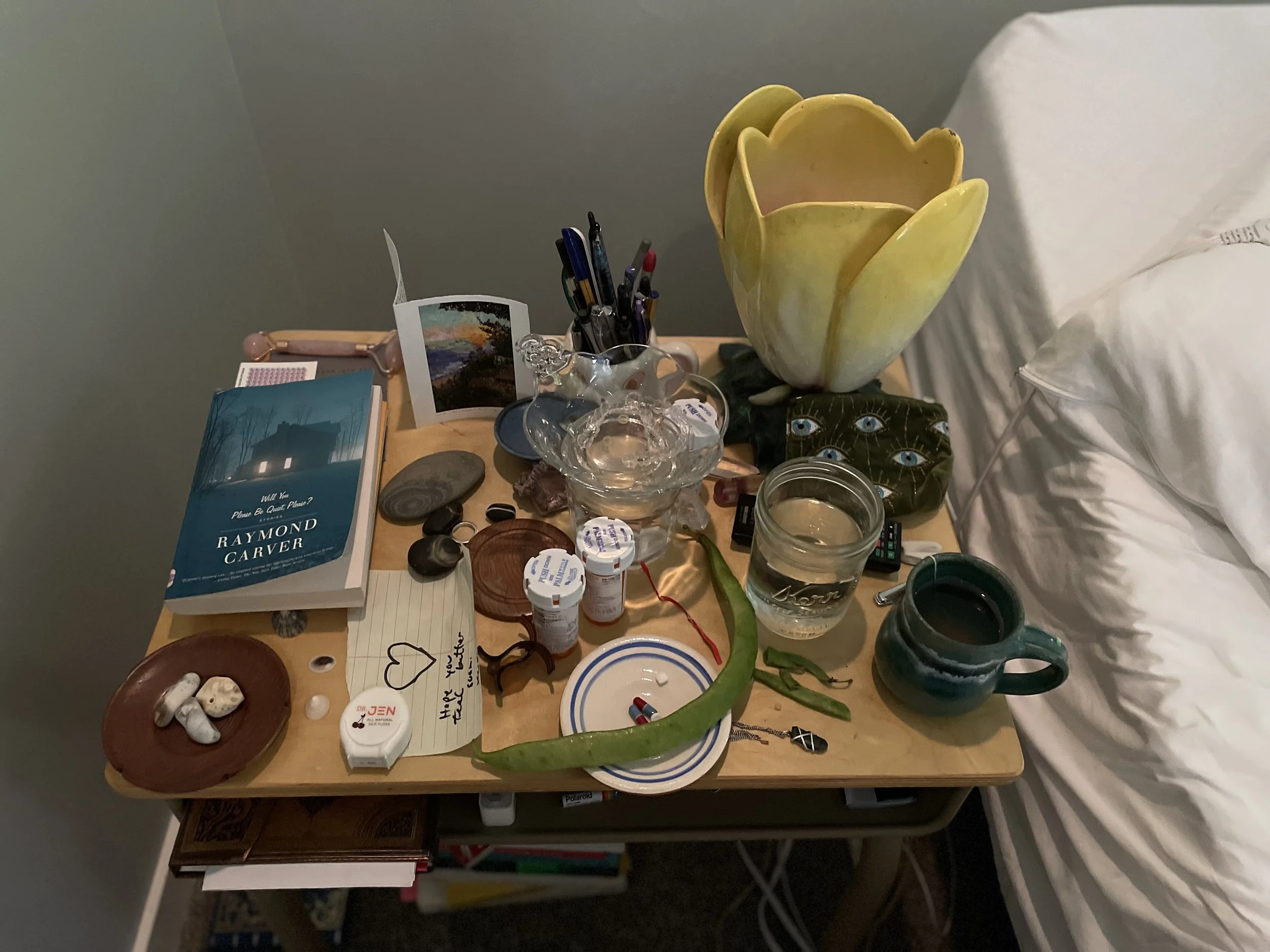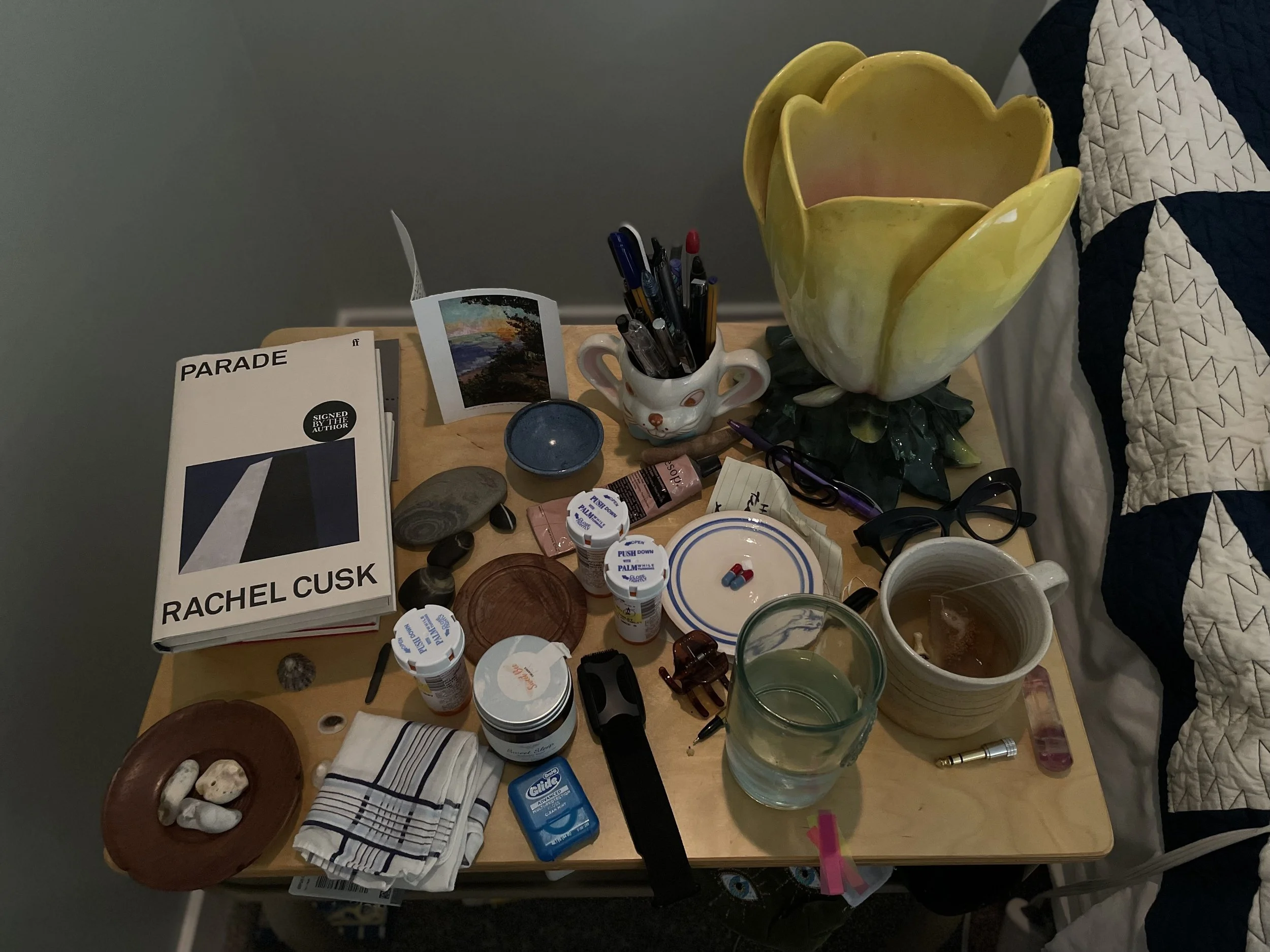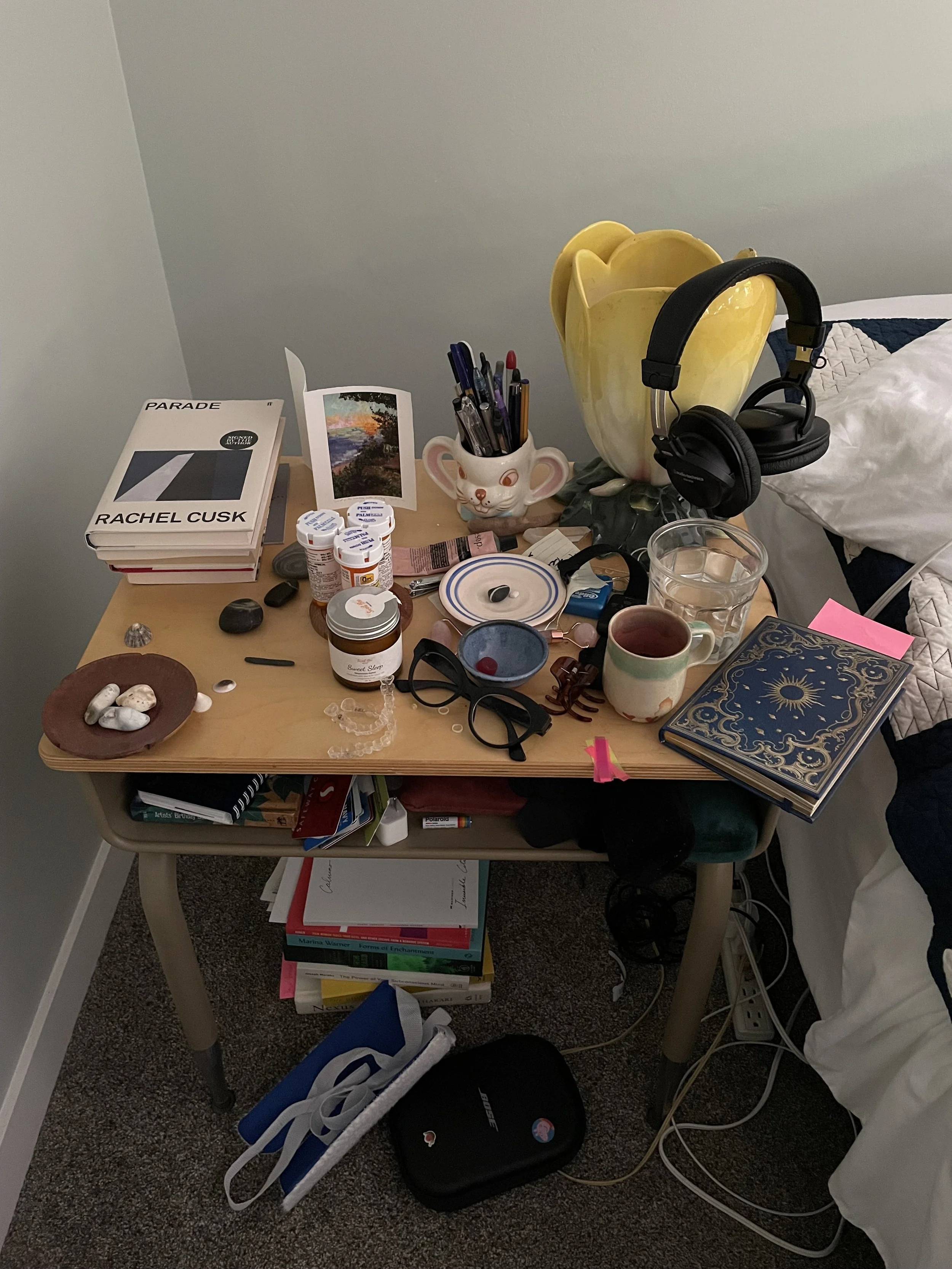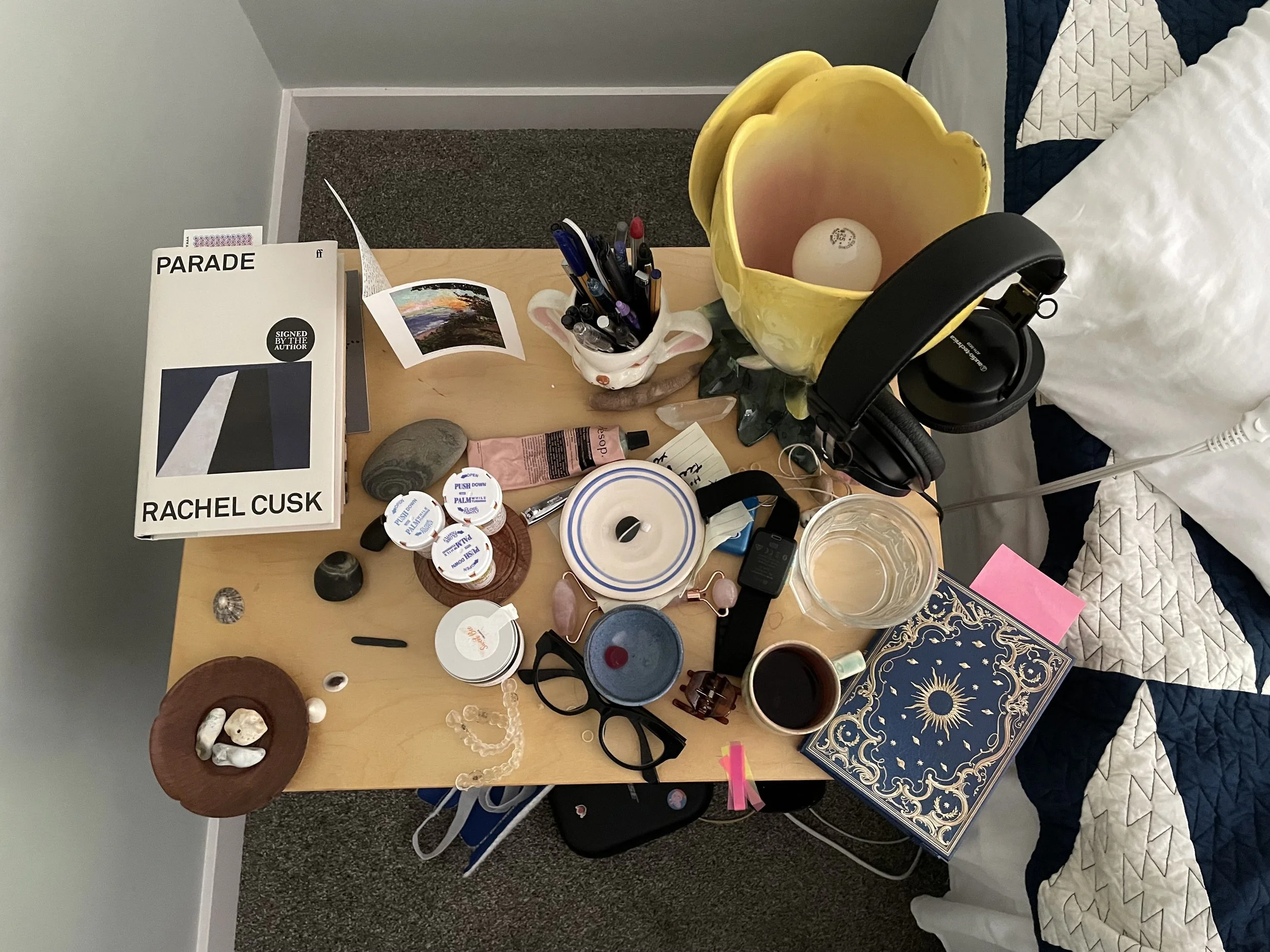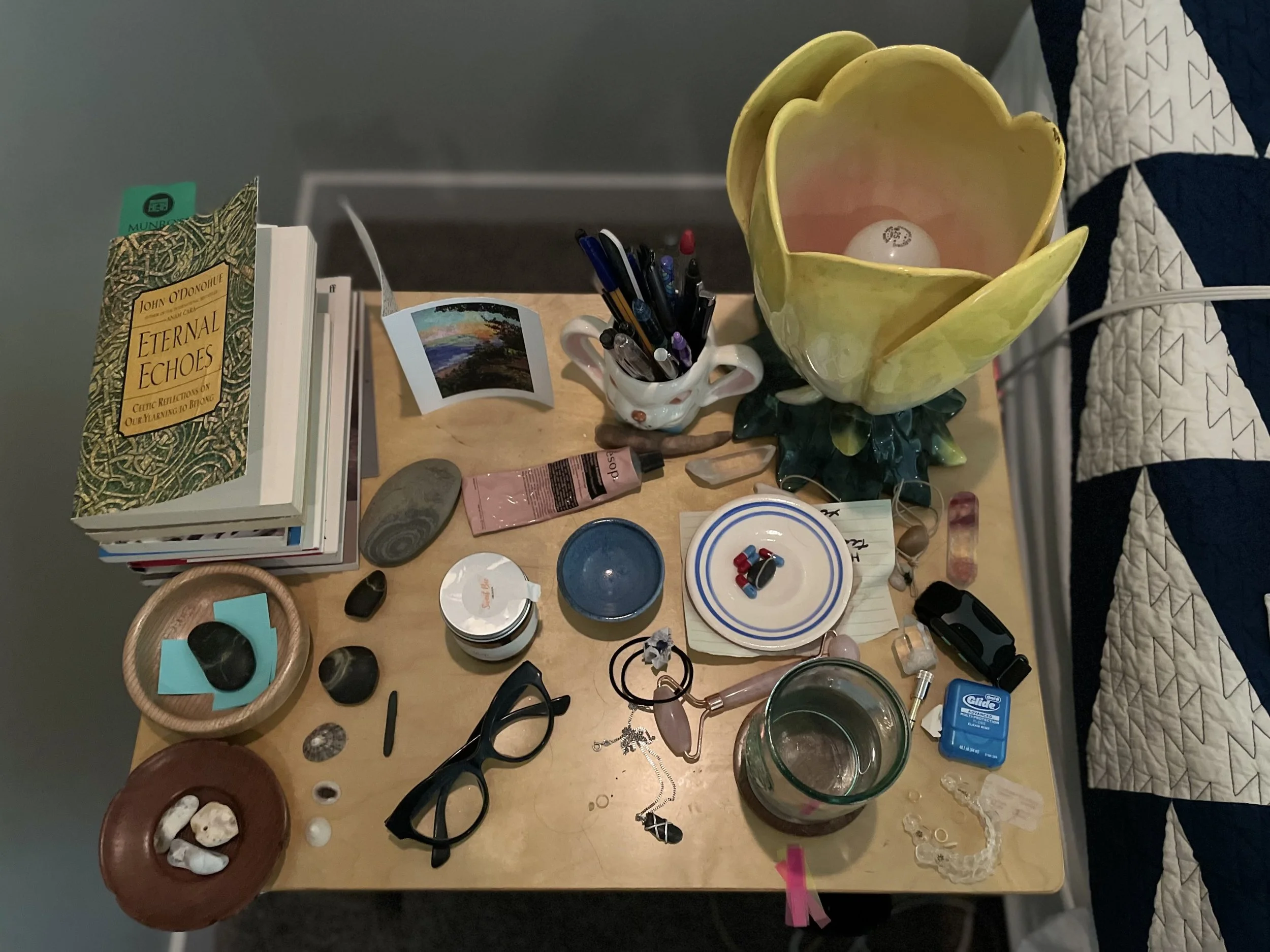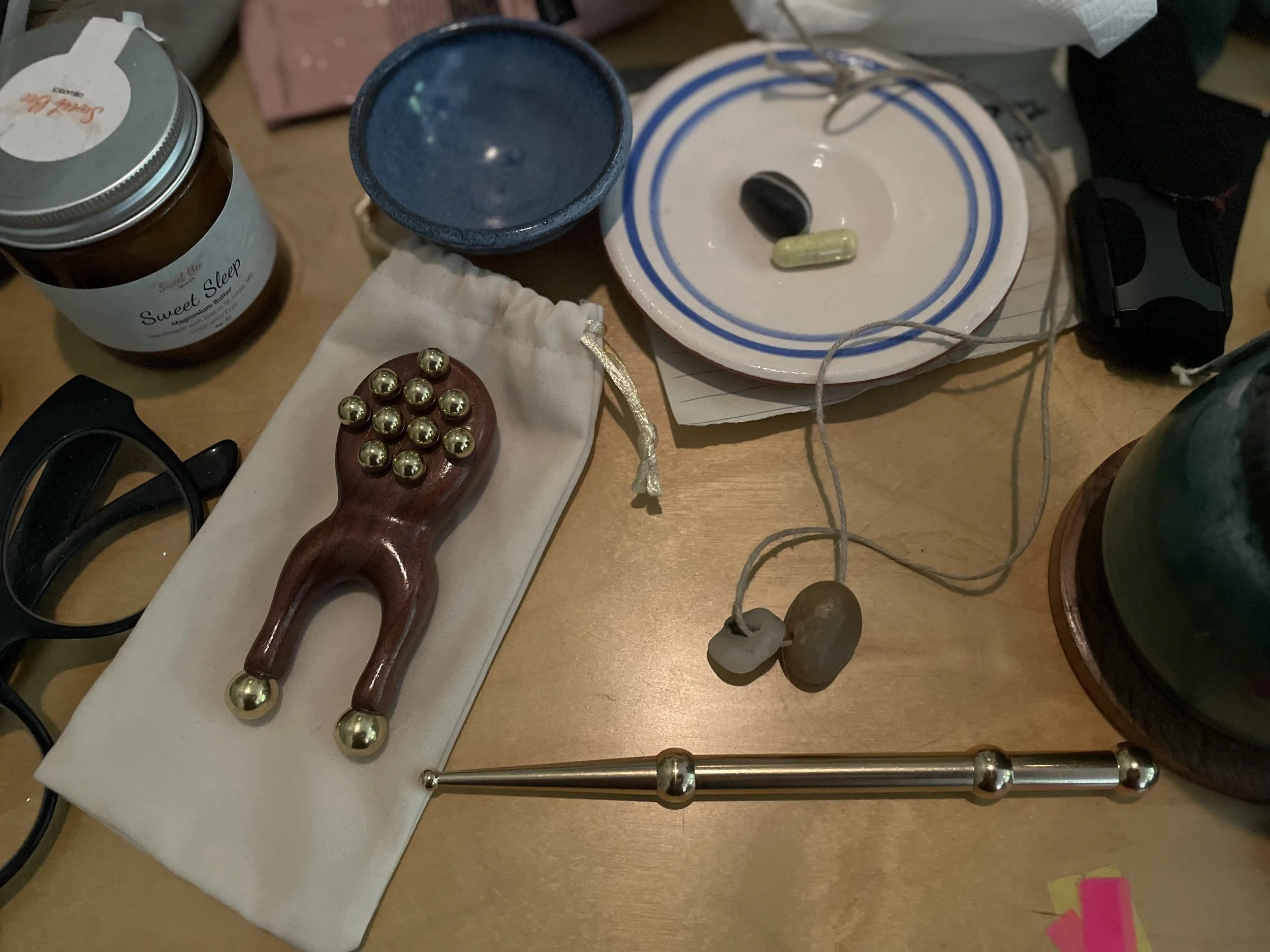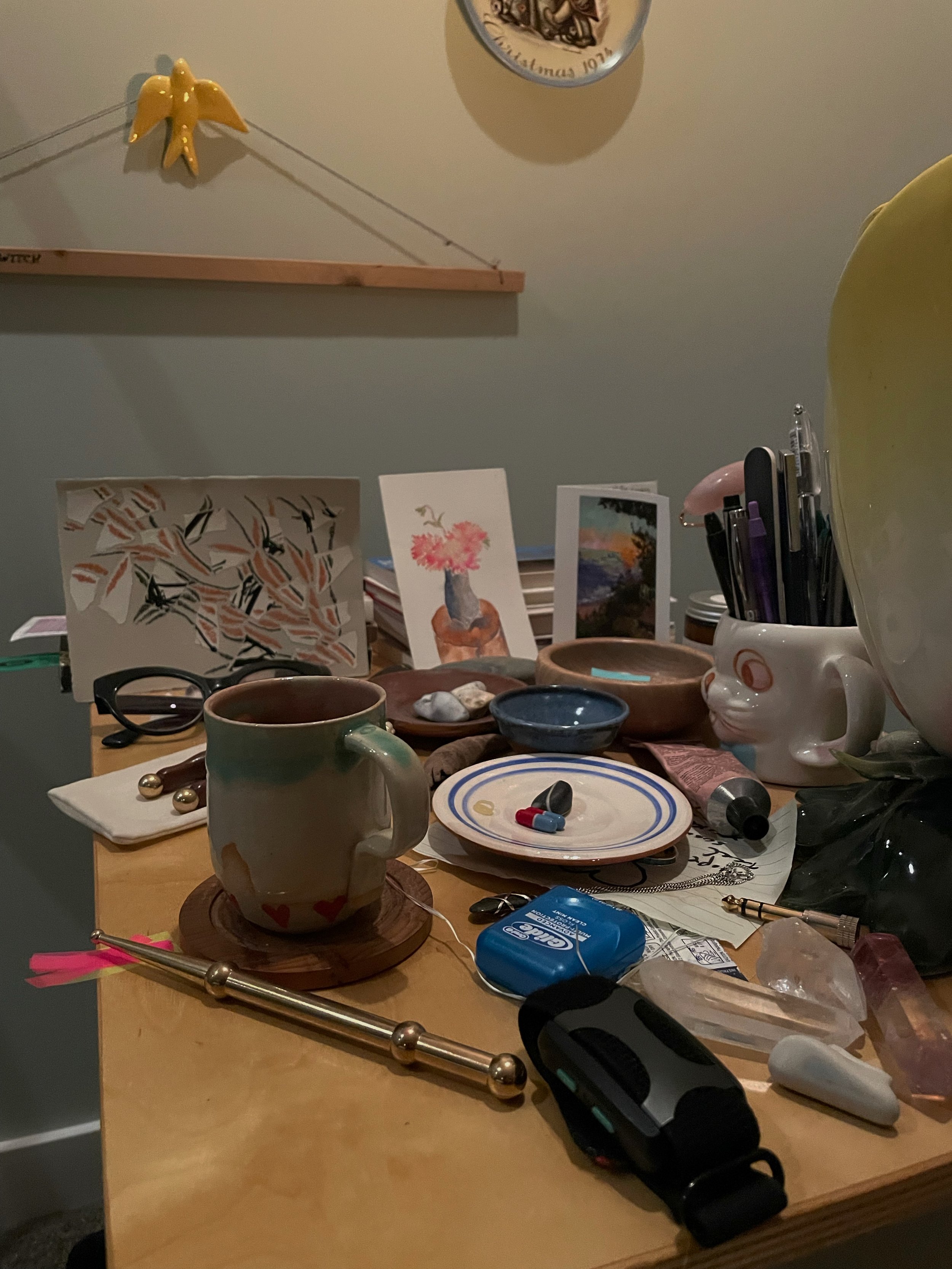A Nightstand Still Life: A Self-Portrait in Objects
A slow self-portrait, made through objects in use.
A Nightstand Still Life is a yearlong photographic project exploring the material culture of chronic illness through weekly documentation of my nightstand. This work investigates the relationship between objects, ritual, and the experience of living with autoimmune disease.
Photographed once per week, the nightstand is not styled or arranged. Objects are captured as they appear, used, forgotten, accumulated, or placed with intention. This durational practice examines how personal items serve as tools of care, comfort, memory, and self-regulation.
The project is an effort to make visible the unconscious rituals of gathering and placement to understand why certain objects are kept close, and how they participate in the embodied experience of illness. It asks what these arrangements reveal about my needs, my rhythms, and the deeper structures of attention and care. By documenting these uncurated arrangements, I aim to reveal the silent dialogues between objects and the body, offering a visual memoir.
Situated within feminist visual practice, object ethnography, and chronic illness studies, the work also considers the gendered dimensions of autoimmunity, the emotional agency of objects, and the nightstand as both a private sanctuary and a site of personal inquiry. It is both documentation and self-examination: a slow portrait of the body in relation to its chosen environment.
April 2025.
My first week, and feeling vulnerable to share my room. I wanted to present the nightstand in context of its wider space, and I might not share this view again.
I observed the imprint left in my bed nest.
I am realizing that the art on the walls are all found objects, or have been given to me. The portrait of the woman belonged to a friend, and neighbor. I have had it for 30 years. The plate was given to me by a dear friend. And the stick, was a tool my Father used to switch the internet on with. All three of these people have passed.
My nightstand objects have been the same for a month now, floating around the space as I shuffle things, but the same. What stands out is seeing for the first time how many objects have found their way there, and how many are connected to people I care about, or who have passed.
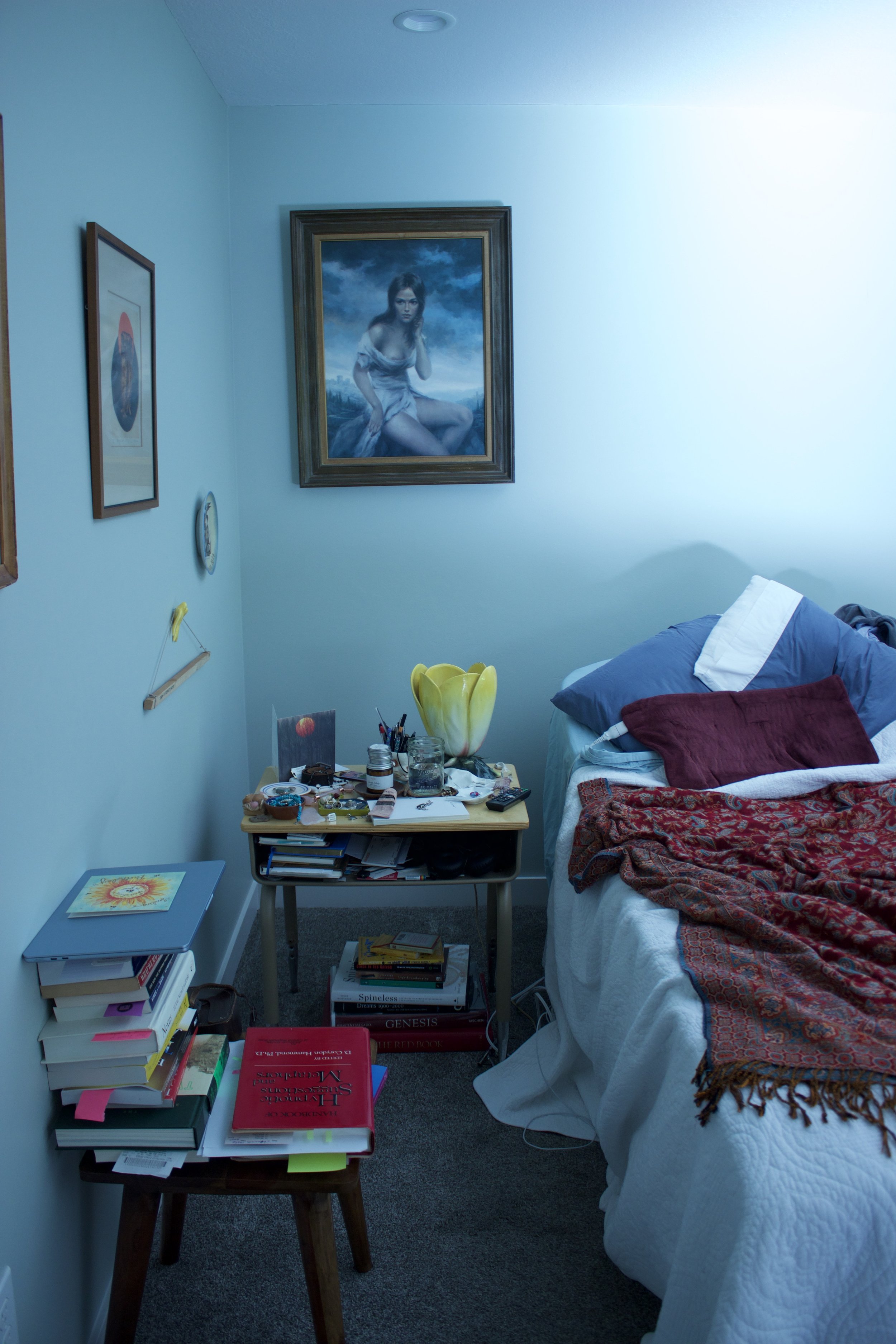

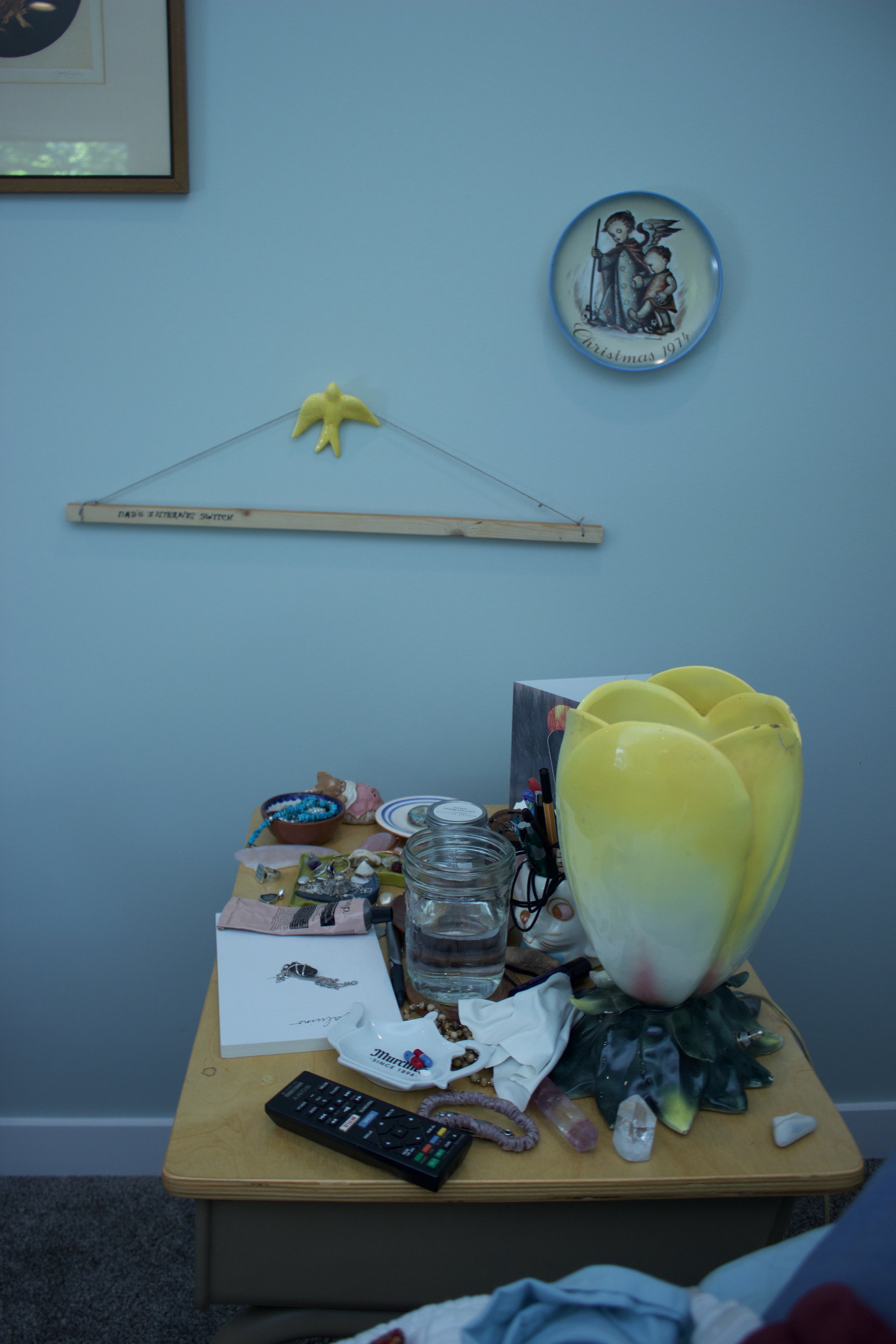
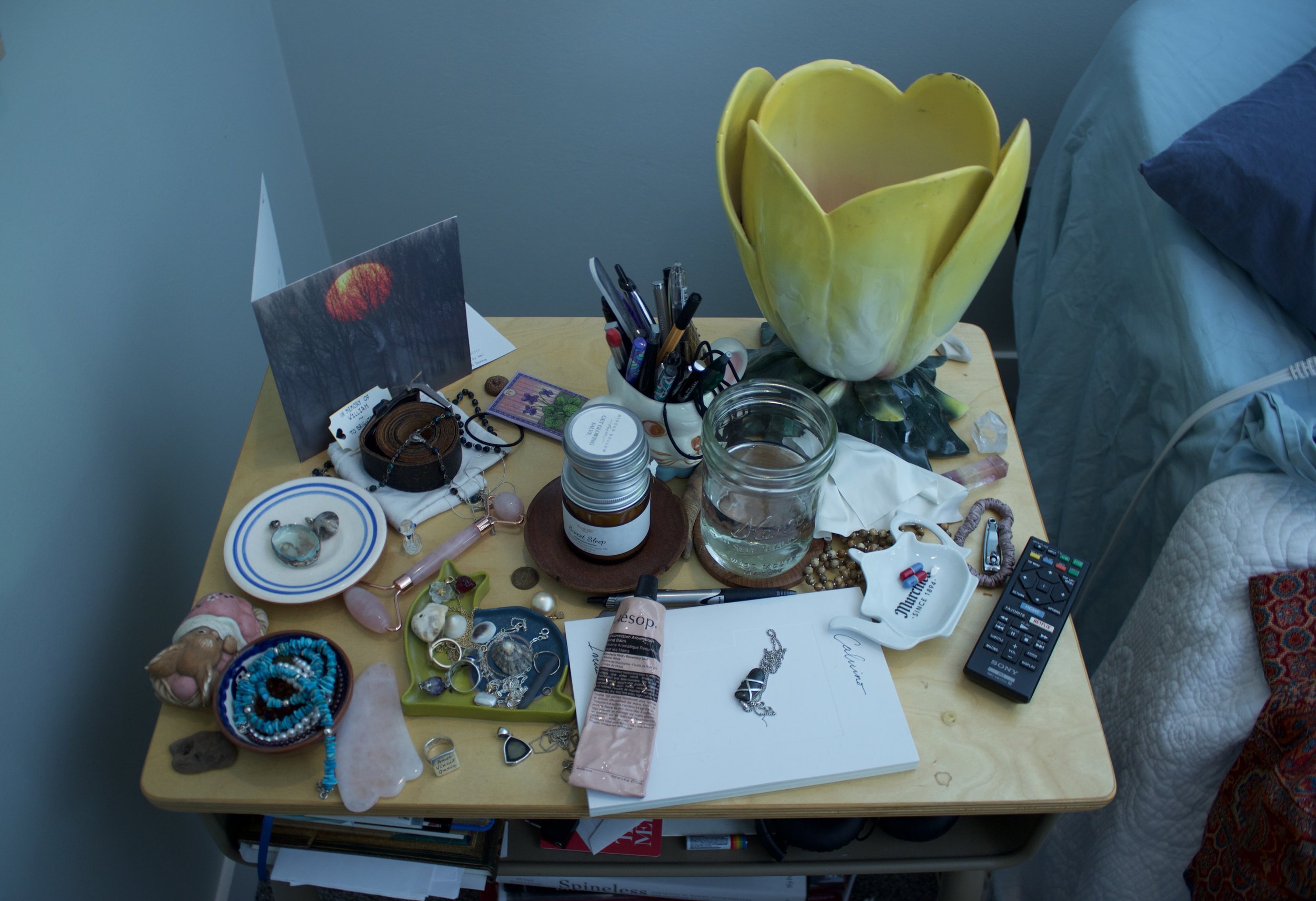
Nightstand Contents
Tulip Lamp from an old friend
3 Crystals
1 Hagstone
2 Rocks
TV remote
Handcream
Wooden Placement made of Yew
Glass of water
Tea Bag Dish from and old friend
Rabbit Mug with my name on the back from an old friend
20 pens
1 emery board
Nailclippers
5 beaded necklaces
4 Neckalces
3 pendants
1 Rosary
3 Rings
Ceramic Sleeping Bunny from my childhood
1 Packet of French Violet Sweets
Handkerchief of my Fathers
Card- Last Xmas card from my Father
Glass duck- From a trip to Whitbey, when I was a child
Belt- Belonged to my Father
5 Hairbands
Rose Quartz Gua Sha
Wooden Dish
3 ointments and creams
1 Dish from Portugal
1 Dog Tag from my dog that has passed
Pendant of my dog’s nose
Glass pendant with my dog’s hair in it.
An old coin
Piece of wood with a hole in it
Book, Invisible Cities, by Italo Calvino
Rose Quartz roller
Glasses cleaning cloth
1 clip on earring
Snail dish
April,
Photographed early Sunday evening with the lights on.
I am noticing the items on here that I don’t use, like the gua sha tool. I feel that it should represent some type of tool for self pampering, but I don’t actually like the way it feels when hauling across the muscles of my face. I just like the coldness of it, and that it is a precious stone. I sometimes just lay it on my forehead, and I like doing that.
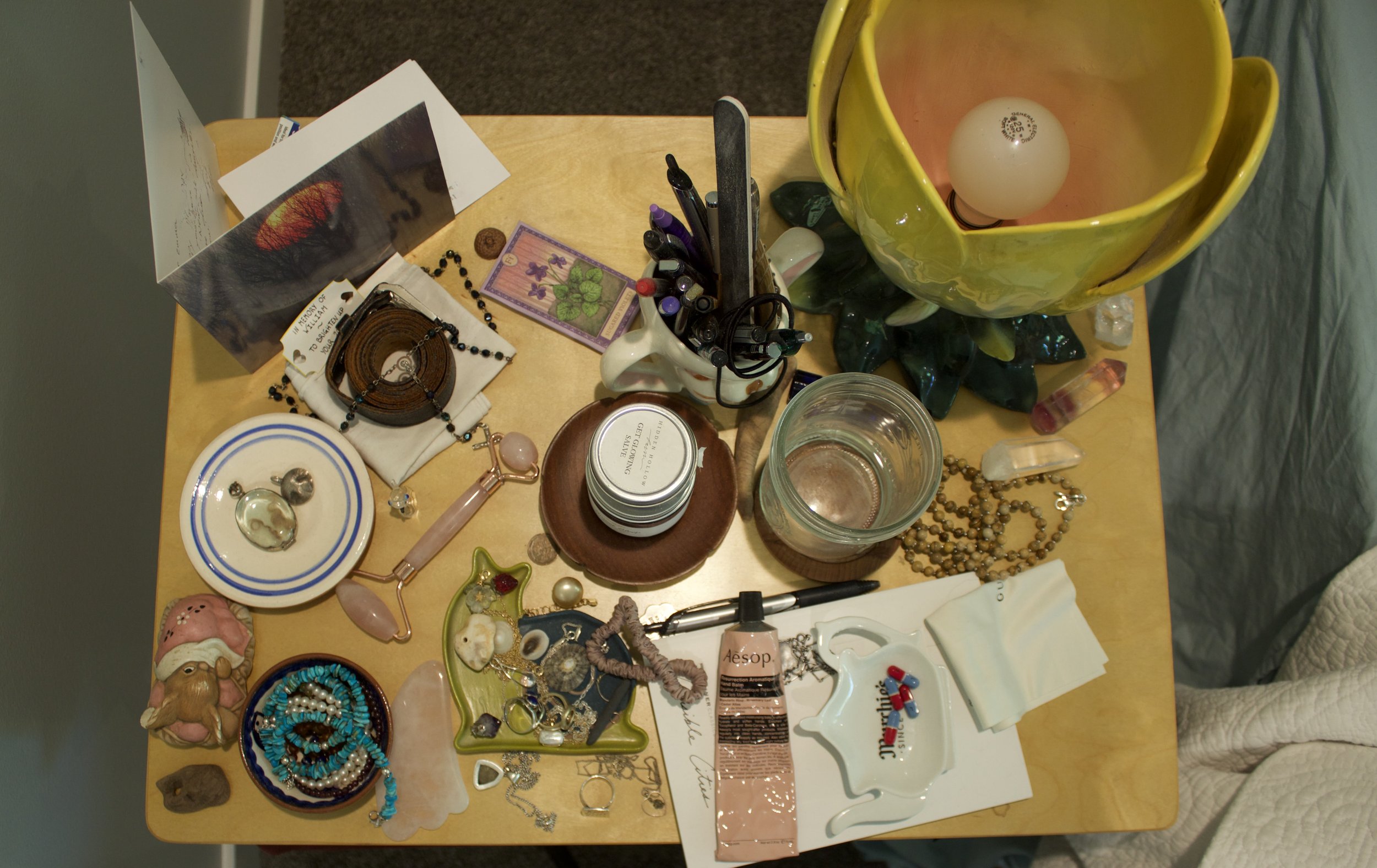
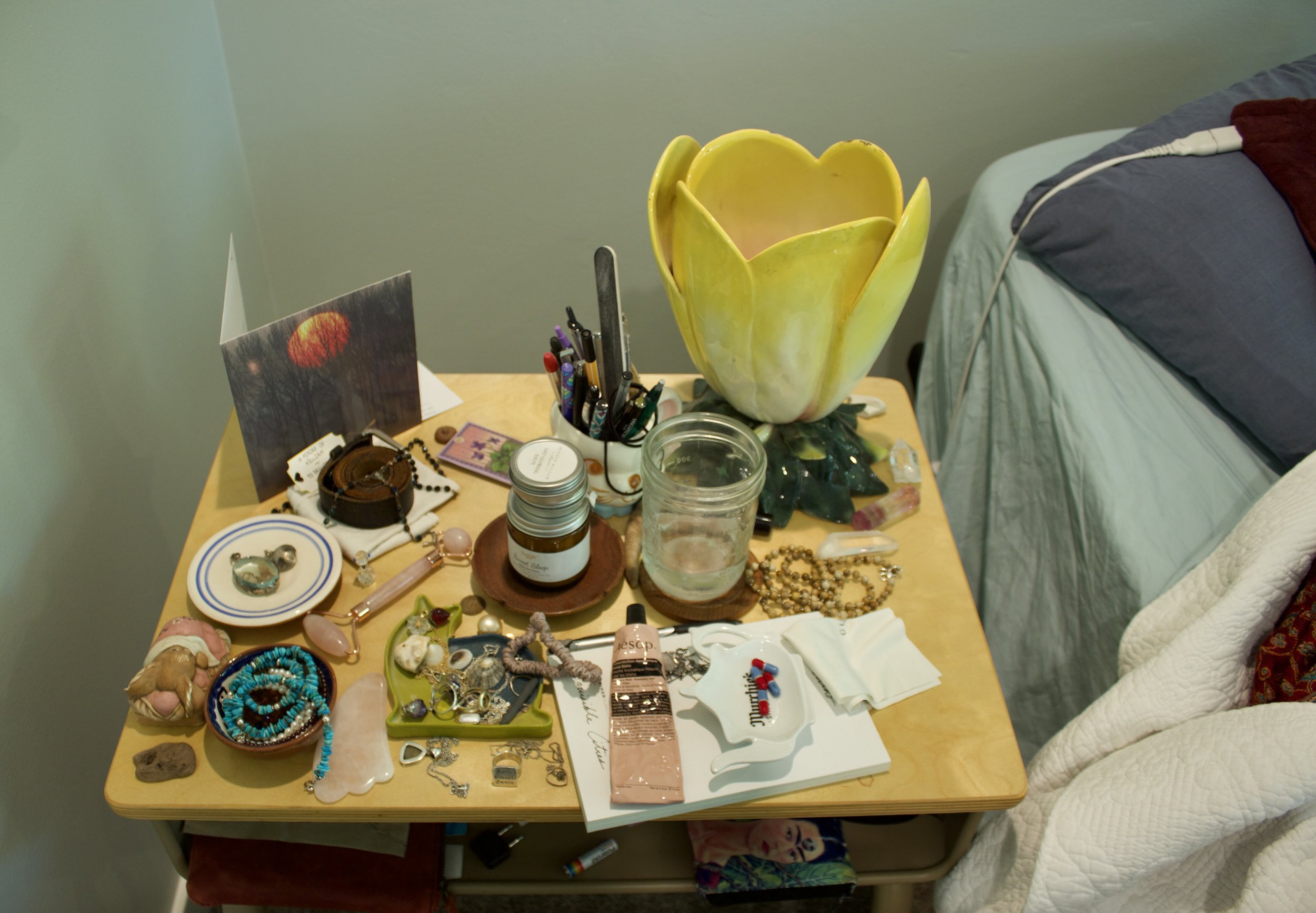
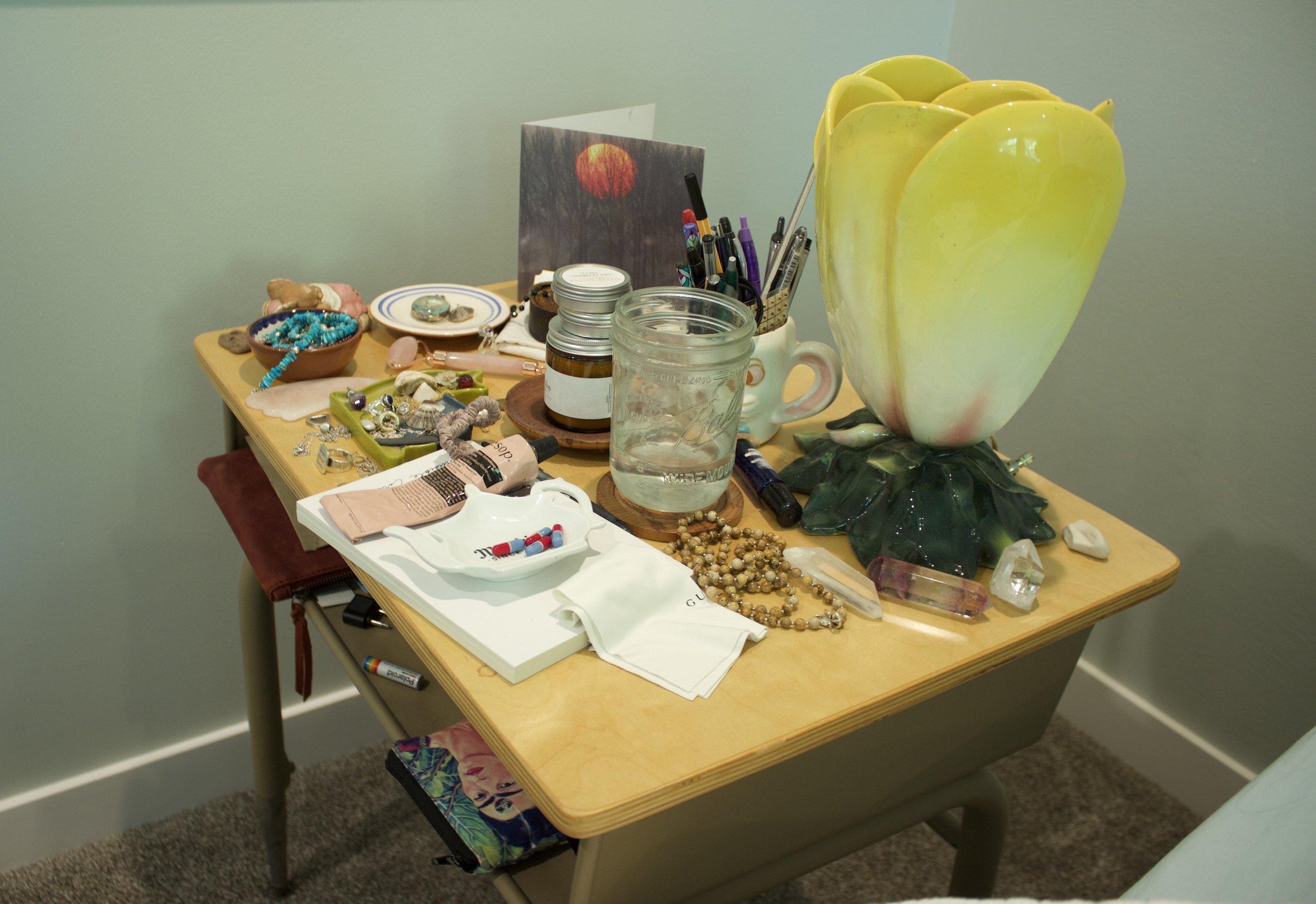
Nightstand Contents
Tulip Lamp from an old friend
3 Crystals
1 Hagstone
2 Rocks
TV remote
Handcream
Wooden Placement made of Yew
Glass of water
Tea Bag Dish from and old friend
Rabbit Mug with my name on the back from an old friend
12 pens
1 emery board
Nailclippers
5 beaded necklaces
5 Neckalces
3 pendants
1 Rosary
4 Rings
Ceramic Sleeping Bunny from my childhood
1 Packet of French Violet Sweets
Handkerchief of my Fathers
Card- Last Xmas card from my Father
Glass duck- From a trip to Whitbey, when I was a child
Belt- Belonged to my Father
5 Hairbands
Rose Quartz Gua Sha
Wooden Dish
3 ointments and creams
1 Dish from Portugal
1 Dog Tag from my dog that has passed
Pendant of my dog’s nose
Glass pendant with my dog’s hair in it.
An old coin
Piece of wood with a hole in it
Book, Invisible Cities, by Italo Calvino
Rose Quartz roller
Glasses cleaning cloth
1 clip on earring
May, 4th
I am already noticing that I am not keeping up with weekly observing.
I rarely look at my nightstand from above. Just when I clean it and rearrange it, which is infrequent. Getting to really look at what I have from above, rather than the view from my bed, is a separate experience. The view from above shows me the layers of objects: the most frequently used near the edge, at arms reach. The ritual objects, and memory objects at the furthest corners.
Nightstand Contents
Tulip Lamp from an old friend
3 Crystals
1 Hagstone
2 Rocks
TV remote
Handcream
Wooden Placement made of Yew
Glass of water
Tea Bag Dish from and old friend
Rabbit Mug with my name on the back from an old friend
20 pens
1 emery board
Nailclippers
5 beaded necklaces
4 Neckalces
3 pendants
1 Rosary
3 Rings
Ceramic Sleeping Bunny from my childhood
1 Packet of French Violet Sweets
Handkerchief of my Fathers
Card- Last Xmas card from my Father
Glass duck- From a trip to Whitbey, when I was a child
Belt- Belonged to my Father
5 Hairbands
Rose Quartz Gua Sha
Wooden Dish
3 ointments and creams
1 Dish from Portugal
1 Dog Tag from my dog that has passed
Pendant of my dog’s nose
Glass pendant with my dog’s hair in it.
An old coin
Piece of wood with a hole in it
Book, Woolgathering, by Patti Smith
Rose Quartz roller
Glasses cleaning cloth
1 clip on earring
Estrogen patch
May 18th,
Last night I dreamt about the pearl clip-on earring that rests on my nightstand, one I found some time ago, tucked in a childhood jewelry box filled with buttons, broken necklaces, and lonely singles. Most of the gathered pieces likely belonged to my Grandmother. I wore the clip on earring for a few hours one day and layed it down on my Nightstand. I don’t remember doing it, but there it is. Last night I was wearing it in my dream. It is not a real pearl. Likely from the 50’s. In the picture it sits next to the book. On the book is a note from a friend to look into an author that she is enjoying right now. This kind of friend note tends to turn into a bookmark.
Nightstand Contents
Tulip Lamp from an old friend
3 Crystals
1 Hagstone
2 Rocks
TV remote
Handcream
Wooden Placement made of Yew
Glass of water
Tea Bag Dish from and old friend
Rabbit Mug with my name on the back from an old friend
20 pens
1 emery board
Nailclippers
5 beaded necklaces
4 Neckalces
3 pendants
1 Rosary
3 Rings
Ceramic Sleeping Bunny from my childhood
1 Packet of French Violet Sweets
Handkerchief of my Fathers
Card- Last Xmas card from my Father
Glass duck- From a trip to Whitbey, when I was a child
Belt- Belonged to my Father
5 Hairbands
Rose Quartz Gua Sha
Wooden Dish
3 ointments and creams
1 Dish from Portugal
1 Dog Tag from my dog that has passed
Pendant of my dog’s nose
Glass pendant with my dog’s hair in it.
An old coin
Piece of wood with a hole in it
Book, Invisible Cities, by Italo Calvino
Rose Quartz roller
Glasses cleaning cloth
1 clip on earring
Note from a friend of an author to look up
Ear seed panel
Wooden stick found on beach
May 25th,
Photographed with my iPhone. Afternoon.
I spent two days in bed, reluctantly, which is rare for me these days.
This is the view of the nightstand from bed, my usual perspective. As I look at this I am wondering why I don’t turn it so the long way is facing me, and I could see it all, and access it all easily. Why the classic set up?
I can’t bring myself to finish the book. Only a few pages left, so I am holding onto it for the right moment to complete it.
Nightstand Contents
Tulip Lamp from an old friend
3 Crystals
1 Hagstone
2 Rocks
TV remote
Handcream
Wooden Placement made of Yew
Glass of water
Tea Bag Dish from and old friend
Rabbit Mug with my name on the back from an old friend
20 pens
1 emery board
Nailclippers
5 beaded necklaces
4 Neckalces
3 pendants
1 Rosary
3 Rings
Ceramic Sleeping Bunny from my childhood
1 Packet of French Violet Sweets
Handkerchief of my Fathers
Card- Last Xmas card from my Father
Glass duck- From a trip to Whitbey, when I was a child
Belt- Belonged to my Father
5 Hairbands
Rose Quartz Gua Sha
Wooden Dish
3 ointments and creams
1 Dish from Portugal
1 Dog Tag from my dog that has passed
Pendant of my dog’s nose
Glass pendant with my dog’s hair in it.
An old coin
Piece of wood with a hole in it
Book, Woolgathering, by Patti Smith
Rose Quartz roller
Glasses cleaning cloth
1 clip on earring
Wooden stick found on beach
June 2nd,
The nightstand is on the move.
I’m traveling, visiting family. Each time I go somewhere, the mobile nightstand grows. It now spans multiple bags: medications, supplements, teas, tinctures, oils. It takes me so much longer to assemble, working out what’s vital, what’s non-negotiable, what keeps the body functional.
Different pouches for different parts of me. All packed into my carry on, just in case the checked baggage gets lost.
Even my teeth and mouth now require their own dedicated kit.
I looked at it all yesterday and thought, wow.
In my twenties, travel meant perfume oils and makeup.
A tiny bag. This time, I didn’t even pack mascara, just one basic eyeshadow.
Now it’s mostly an array of different types of antihistamines. Anti-inflammatory support. A daily ritual of systems maintenance.
Most of these things wouldn’t live on my nightstand. But I use them all, every day. Seeing them crammed into one zone of care, it strikes me, how much of illness lives in the margins of space, and how slowly the body teaches us what it needs. It has taken me this long to be able to truly hear what my body wants, rather than just push through the symptoms.
Book featured: Still Life: Notes of Barbara Loden’s Wanda (1970), by Anna Backman Rogers
Nightstand Contents
Water Bottle
1 Glass of water
Hand sanitizer
3 bottles of supplements
Glass roller
Perfume oil
Face Cream
3 hagstones
2 Shells
Journal
Deodorant
Plug
1 pen
Book, Still Life: Notes of Barbara Loden’s Wanda (1970), by Anna Backman Rogers
4 Pouches
1 Hairbrush
Medications
3 Hagstones
1 rock
June 8th
Everything that I need to tend to my body is now gathered in a complex array of pouches around my nightstand. Each pouch separated into different needs. It feels a bit chaotic, but also soothing to return to the nightstand for everything. Most of these items would be in my bathroom, or in a wooden cabinet, that I call my, ‘Health Center’. Having them all right next to me is strange.
For years now I have a ritual for my evening meds. I put them in a dish, that a friend gave to me. I get in bed, and take the pills right before I go to sleep. My friend, neighbor, would always prepare her own medications by placing them into a little red ceramic dish. I really resonated with this as a ceremony, rather than just taking them straight from the plastic brown pot. Now, while I am visiting family, I am using this dish. I made it myself in a pottery class, not very well, but I had fun. I am using it here for my nightly meds, they will sit with these shells that I just gathered from my favorite beach.
Nightstand Contents
Hagstone necklace with twine
2 Glasses of water
Hand sanitizer
3 bottles of supplements
Glass roller
Perfume oil
Face Cream
3 hagstones
2 Shells
Journal
Deodorant
Plug
1 pen
Book, Still Life: Notes of Barbara Loden’s Wanda (1970), by Anna Backman Rogers
4 Pouches
1 Hairbrush
Medications
3 Hagstones
1 rock
Ceramic dish
Medication organizer pouch
Estrogen patches
Necklace
Bag of chocolate
Invisalign rubber bands
Vulva balsm
June 15th,
I am in a new place for a week. My nightstand is now just a collection of bags on the floor next to the sofa bed I am sleeping on.
Two years ago I had a major spinal injury. I am grateful that I have healed my spine enough that sleeping on couches, and campbeds are not impacting me. I have come a long way since then. At that time I was walking tiny steps with a cane, could only stand or lay down on my right side, sitting was impossible for about a year. I was consumed with the moment to moment management of pain, and trying to maintain full-time employment.
My life was the smallest it had ever been. While my life expanded during Covid, it folded into itself after the injury. I lived for months tilted and twisted to the right, the world had slipped sideways, and I followed. I was so fearful, and I thought that this would be my life forever. I lived in three rooms. I did a hefty amount of catastrophizing that I would never be able to get on a plane, walk on a beach or just be pain free again.
So, I don’t take this ability to travel for granted. I am deeply grateful to be able to tie my own shoes. Each time I tie them I bend in a prayer of gratitude. That time filled me with a new urgency, to care for my body fully, so that I can do the creative work that I am called to do. I feel a pressing need to create, and not waste time, which is more than my age calling.
And that is why is has been so interesting to watch myself completely become frozen in not being able to take care of all of the parts of me. I’m getting the basics done, but not all the tending.
Being out of my space has disrupted my routine, and for reasons that I don’t understand, that disruption has resulted in me just not doing some basic care for myself. The objects next to me are not enough. I am disconnected from the deeper ritual of self care.
Last year I was diagnosed with a new autoimmune disease that requires a nightly routine, and since traveling I have just simply not done it. I am now feeling the physical ramifications of that, and yet, I am still not able to get back into caring for myself. I am collapsed, and adrift.
I am home with family. And thinking about how generations of my ancestors cared for themselves. My parents were hard working, thrifty and did not prioritize themselves, or their comfort. Their parents, too, emerged from war, from ration books, making clothes, and therefore utility, not rest. My ancestors did not have the luxury of time and resources to care for themselves fully.
And so I find myself unmoored, and wondering if my self care is lavish? Is this freeze a legacy too, the instinct to suppress one’s own needs in the face of others simply being around?
In ways that I do not yet understand, the physical space that I am in plays an important factor in being able to actively care for my body me. I need complete privacy to truly tend to my body.
I am not yet a walking home for myself, able to take up all the space that I need to care for myself fully, wherever I go.
The objects I carry with me are not enough.
Nightstand Contents
Book, Still Life: Notes of Barbara Loden’s Wanda (1970), by Anna Backman Rogers
Sandwich bag of Hazelnuts
2 Sandwich bags of supplements
Hairbrush
pouch with medications and creams
Leather pouch
Perfume oil
Glasses case
Journal
June 22nd,
I am in another location, staying with family.
For some reason I was unable to set up anything on the actual nightstand, and instead threw everything on the laundry hamper at the end of the bed. Not helpful, but it is how it landed, vomited out of my bag. A Child in the house so I’m careful to pack up all my meds when I am not in the room.
Generally, I am feeling haphazard, and frenetic. Dancing with the heat, and the determination to push myself to do more exploring and consuming of art. Visited Derek Jarman’s Dungeness Cottage. What a treat. What a magical, ethereal spot. So grateful to have seen it, especially as I have been reading, Modern Nature, now I can get deeper into that book. I will be able to transport myself there. It is a place that exists on another realm.
And all this divine adventuring does have consequences. That is the word that I use- consequences. I can do things. I can push myself. I can, but, there are consequences that other folks will not experience. Those results will need to be managed and time scheduled to do so. For me, it lands me in a chronic pain and chronic exhaustion cycle. So, I want to share the $2.50 tool I use to manage my pain.
I have spent so many years trying all kinds of things for pain, foam rollers, machines that hammer the muscles, saunas plastic rollers, balms, ice, trigger hooks, heat, massagers, TENS machines- you name it and I have tried it. Faithfully. And each time I would become so confused as to why these gadgets would make me worse! So began the long journey to understand the really unique needs of my body. The best tool I have for getting out of pain is a $2.50 glass perfume bottle with a metal roller. I just hold the roller into the fascia, and my trigger points, and I hold, and hold, and finally I feel a release. Then I put on ice, and then the next day I will feel it starting to let go.
Most pain tools are built for bulk, designed with the assumption of thick muscle, dense tissue, and high-impact athletic recovery. And those tools would just glide over my pain and make no impact. They’re made for bigger bodies that need pressure in motion over larger areas. But what about bodies that can’t? What about fascia that is so tight and inflamed that it should not be hammered with a massage gun, or joints that dislocate rather than tighten? Most rollers, or trigger hooks, are too large, too aggressive. Even the small rollers on the market are too big for the fascia I am working on, and they assume a kind of resilience I don’t have. I’ve spent thirty years testing tools that left me worse, more inflamed, more confused. And I keep wondering: why hasn’t anyone designed something for us? For those of us with Ehlers-Danlos? Or, for women with chronic pain, our needs are different. I think it’s time for a different design logic. A feminist ergonomics. Tools shaped not for domination but for dialogue, ones that meet the body with precision, and listening.
This simple roller speaks to my fascia in just the way that it needs. It has taken me 30 years to find the perfect combination of tools. My roller, hypnosis, and ice. Trifecta of wonder.
Photo take with my iPhone- image 1 is first day, image 2 is second day. Blue Roller is pictured bottom left, next to the medication box.
Blue Roller shown here at the bottom of the hamper, near the Nivea.
Nightstand Contents
Apollo Neuro
Plug with charging cable
Medication Organizer pouch
Inhaler
Estrogen path
Zinc stick
Face cream
Roller
Comb
Muscle rub oil in roller
Saline spray
Medication screw pot
Bose headphones
Invisalign rubber bands
Pouch with medications and creams
June 29th,
My nightstand is getting out of control, but I enjoy looking at the items here. The string is from my father’s workshop. He passed last year, and this is my first trip to a home without him. It has been very difficult. I have been spending time in his workshop with all his tools, his wonderfully labeled boxes and tubs. It smells like him. I’ve been photographing it as a kind of ritual, spending time with him through his belongings. Brown twine reminds me of him, and his creative solutions to fixing things. I am using it to make necklaces out of the Hagstones that I have gathered on the beaches here. A double layer of comfort, protection and power- the Ocean Hagstone, and my father’s twine. I started collecting Hagstones when I was about ten. They’ve always fascinated me, and I can feel that ocean strength within them. This is my witchy part. I don’t usually talk about this side of myself—the part that believes objects carry power, and that energy lingers from other people.
My last few days away, and getting nervous about the long journey home. I find travel so much more grueling than it used to be. All of it. The crowds of people, noise, and how tightly they pack you into those planes. It wears on my body that takes time to recover from. And frankly, my stomach is just becoming the barometer of stress. I can plough through life, and hold all the complexities, and pressure….but my stomach lets me know when I am really at capacity. IBS is likely what I am dealing with here.
Of all my diagnoses, this one I find to be the most difficult to deal with, the one I find most isolating. I am aware that it can cycle into anxiety and a resistance to leaving the house, and I just refuse to let that happen. I’ve always lived my life with bold moves and risks, and yet, underneath that, my body is vulnerable and sensitive. I find it frustrating. I want my body to match my inner version of my goals. This is the daily dance, not getting trapped in irritation, but learning to push myself just far enough without crashing.
I am allergic to being perceived as weak.
Nightstand Contents
3 glasses of water
Twine from my Fathers workshop
Ceramic dish- that I made
2 Shells
Face Cream
4 Bottles of supplements
4 Hagstones
Hagstone necklace with twine
Necklace
Book, To The Lighthouse by Virginia Woolf
Medicine Mama Vulva balm
Nail clippers
Medicine case
Braces case
2 Glasses cases
Face wipes
Pot of medication
perfume oil
Bottle of water
July 6th,
Returning home after a really long journey of delayed and canceled flights, and the cumulative exhaustion of being away from my routine. I am in a phase of radical attending to the needs of my body, mind and spirit to repair from this journey away. This has been a grueling trip away to navigate some family dynamics that are really challenging. And while, I seem to have entered some post traumatic clarity, it has taken a toll. It has been a really intense time, and I have found myself in a state of freeze a great deal. In that place, all tending to my body stops. There’s shame, too over how quickly I stop doing what I know helps me. Now, I find myself almost frantically, hungrily doing all the things that I know help me. As if trying to make up for the loss of the last month.
My nightstand is in a state of disrepair, and clutter. It does not feel helpful, or soothing. It has turned into a jewelry box, for a time having those stone items near me was comforting, now it just feels cluttered and confusing. Even the items that belonged to my father, once grounding, now feel like too much. Too weighted with complicated stories.
Being alone again is a balm. I can get into the rhythm of the day, and hear clearly what my body needs. I am not on constant standby for the emotional needs of someone else. Where I seem unable to hold two things, my own needs and being available for family, on stand by. I am doing the things that I love to do when I am alone, like morning dancing rituals, praying aloud and having long friend conversations. All of which are just the best of medicines for me. I am taking my time in doing all things, languishing, which feels self indulgent and decadent.
Nightstand Contents
Tulip Lamp from an old friend
3 Crystals
1 Hagstone
2 Rocks
TV remote
Handcream
Wooden Placement made of Yew
Mug of coffee
Tea Bag Dish from and old friend
Rabbit Mug with my name on the back from an old friend
20 pens
1 emery board
Nailclippers
5 beaded necklaces
4 Neckalces
3 pendants
1 Rosary
3 Rings
Ceramic Sleeping Bunny from my childhood
1 Packet of French Violet Sweets
Handkerchief of my Fathers
Card- Last Xmas card from my Father
Glass duck- From a trip to Whitbey, when I was a child
Belt- Belonged to my Father
5 Hairbands
Rose Quartz Gua Sha
Wooden Dish
3 ointments and creams
1 Dish from Portugal
1 Dog Tag from my dog that has passed
Pendant of my dog’s nose
Glass pendant with my dog’s hair in it.
An old coin
Piece of wood with a hole in it
Book, Woolgathering, by Patti Smith
Rose Quartz roller
Glasses cleaning cloth
1 clip on earring
Wooden stick found on beach
Scissors
Letter from a friend
2 used estrogen patches
Apollo Neuro
July 12th, 2025
I am still recovering from my trip away. Peeling back all the layers of this complex trip home, and noticing all the ways my care for myself falls away when I am inside old dynamics. I’ve been slowly reminding myself what care actually means. Rebuilding the small, steady routines that work for me. And unraveling the subtle threads of shame that still surface when I engage in care. That’s a thread worth returning to.
When I look at my nightstand, I see a gathering of objects that are no longer feel intentional. Slowly, over the last couple of years, the gatherings of the items on my nightstand are more, and more items associated with my grief than support. Objects connected to people I’ve lost, to beloved animal family, to complex relationship. It is turning more and more into an alter of loss, than items that anchor my body in health.
And then, jewelry began to creep in. Items that I love, and feel comforted by. I don’t really have a place for them, so they end up in bags and small bowls, scattered around the house. A few pieces help me feel grounded, and beautiful. But too many just feel like noise.
I have house guests coming in a couple of weeks, and they will be in my room. This is making me spend some time cleaning up and organizing all the spaces that friends don’t normally see. And an invitation to clean my nightstand. I want to start again.
I decided to start this by taking away the grief objects, the ones that don’t feel healing right now. And although, grieving really is a full body experience- I no longer want them sleeping beside me. I have another space in my workshop where I am going to put them. So here are before and after pictures, removing grief items.
This process has been a really powerful one, and liberating. Clearing the nightstand felt like opening a psychic window, suddenly, there was room to breathe my own story again.
Nightstand Contents Before
Tulip Lamp from an old friend
3 Crystals
1 Hagstone
2 Rocks
TV remote
Handcream
Wooden Placement made of Yew
Glass of water
Tea Bag Dish from and old friend
Rabbit Mug with my name on the back from an old friend
20 pens
1 emery board
Nailclippers
5 beaded necklaces
4 Neckalces
3 pendants
1 Rosary
3 Rings
Ceramic Sleeping Bunny from my childhood
1 Packet of French Violet Sweets
Handkerchief of my Fathers
Card- Last Xmas card from my Father
Glass duck- From a trip to Whitbey, when I was a child
Belt- Belonged to my Father
5 Hairbands
Rose Quartz Gua Sha
Wooden Dish
3 ointments and creams
1 Dish from Portugal
1 Dog Tag from my dog that has passed
Pendant of my dog’s nose
Glass pendant with my dog’s hair in it.
An old coin
Piece of wood with a hole in it
Book, Woolgathering, by Patti Smith
Rose Quartz roller
Glasses cleaning cloth
1 clip on earring
Wooden stick found on beach
Letter from a friend
Hagstone necklace on twine from my Fathers workshop
Attachment for my camera
Nightstand Contents After
Tulip lamp given to me years ago by a dear friend
3 Crystals- 1 I use for trigger points on my face
1 soothing rock
Handcream
Teabag dish that I use for my nightly medications- was given to me by a dear friend
Rose quartz roller
Yew wooden placemat
Glass of water
Stick found on the beach that looks like a Witches finger- so is magic
Rabbit mug given to me by a friend- it has my name on the back
Wooden dish
1 Hagstone
2 Rocks
3 Shells
Letter from a friend
Book, Woolgathering, by Patti Smith- that I can’t finish because I don’t want it to end.
Book, Terrain Land into Art, by Lizzie Lloyd
18 Pens
1 nail file
July 19th,
Living with my refreshed Nightstand has been a really interesting experience. I feel more connected to the space now, and mentally clearer, by this cleanse. Whereas before I would have found comfort in layers of objects, especially ones tied to people who have passed. I am discovering that not having those objects there has been liberating. That brings up complex feelings. But their absence has meant that I can start to hear myself. Which in turn is what this time has been about for me. A time for deep stillness. And this is a reminder to me that objects speak with their own history, and I am discovering that all the history on my nightstand was just drowning me out. And, its not to say that I don’t love those people, and how they shaped my life. But I am at a turning point. I am just at this really powerful stage in my life, going through some kind of transition. And I just need to hear myself. I think this is partly the ritual of menopause. And also having a reckoning with patterns, some inherited, and some from long standing relationships. This time has allowed me to see how I have been conditioned to attend to others as a way to be connected. Just intentionally clearing this tiny space of my nightstand has allowed me to feel more at home in myself.
It is also making me think a lot about the power of objects, and their own spirit. Not just having something beautiful next to you for soothing, or uplifting, but that the essence of that object vibrates. I do believe that the vibration of objects can enter our dream space. And if these are not the symbols that I need to be working with, then the dream landscape can get muddled.
This week I changed out my pill ceremony dish. It used to be a tea bag dish that I friend, and neighbor had given to me. I have exchanged it with a dish that I bought in Portugal. Its not quite what I want for my ceremony dish, I will be on the look out for some handmade smaller dish.
Nightstand Contents
Tulip Lamp given to me by a dear friend, many years ago.
Rabbit mug with my name on the back of it- given to me by a dear friend
16 pens
1 emery board
Hand cream
Apollo Neuro- modified with two straps so that I can wear it around my neck for my Vegas nerve. Of all my health tools this one has been a life changer (I do not get paid to say anything about this product)
3 shells
1 wooden dish
6 stones- with 1 Hagstone
Rose quartz roller
1 coaster made of yew wood from England
Letter from a friend
Book- Woolgathering, by Patti Smith- still can’t bring myself to finish it.
Book, Terrain Land into Art, by Lizzie Lloyd
1 ceramic dish- from Portugal on my 50th birthday trip with my Brother
3 Crystals
1 beach ceramic chunk
1 piece of wood, found on the beach, that I call a wand.
1 glass of water
2 tylenol
1 pepcid
July 27th,
This week I had a dream about my nightstand. In the dream I went to another part of the house and picked up a smooth black rock. I held it in both hands. Then I started to rub my hands together really fast, as though I was activating the rock. This brought a great sense of power and joy, as though I was creating a spell. As though I had remembered something I had always known about myself, and about life. I took the rock and placed it on my nightstand.
I have 3 black rocks in my life. One is on my desk at work. Between appointments (and sometimes during) I hold it in my hand, I find it really grounding. It is a rock that sits just perfectly in my hand. I have another black rock on my desk at home, this one has a white circle around the top of it. The third black rock has been sitting in the living room. This is the rock that I gathered up and placed on my nightstand. I think that all three of them are basalt, and all three were gathered locally.
It is said that a rock with a ring around it is a special rock for witches to make wishes. The ritual is to rub the white ring while making a wish. I carry several small ones in my coat pockets for wishing rituals.
I gathered my black rocks and have placed them all on my nightstand. This way, they can give me their messages and power while I am in the liminal space of sleep. As the days have passed I keep thinking about holding the rock and rubbing my hands together. The image just pops into my mind. I don’t know what it holds, but I know that something is working through it. I feel as though it is a ritual of waking a part of myself that has been asleep, undervalued, and in protection mode. I am making some big changes in my life, and they require tremendous self belief. The dream gave me this joy that everything was possible, and that each micro step I make is activating a part of me that has been waiting for this time. I know that they have more messages to give me on how to keep on this path, and how to connect with this deep part of myself that is waking.
I keep a running list of all the items on the Nightstand collective project, and the 2nd most featured item are rocks and crystals. Across all nightstands from all cultures, and many Countries. And I think a lot about this a great deal. How humans have gathered rocks as sources of comfort, as tools, as gifts from far away places. Same with shells. When life is in turmoil, there is something so calming about holding an ancient rock. And I think a lot about the gifts that rocks bring to all the nightstand portraits, and why. For me, holding a rock is soothing because of the cool weight. It is a tactile reminder to the body that this rock has been shaped by forces stronger than us, heat, pressure and time. It holds the stories of rivers, tides and mountains. We can project onto rocks our rituals, wishes, magic and grief. They are a quiet anchor to the ancient that soothes the nervous system. I would like to know more how the other nightstand participants use rocks as healing tools.
Nightstand Contents
Tulip Lamp given to me by a dear friend, many years ago.
Rabbit mug with my name on the back of it- given to me by a dear friend
16 pens
1 emery board
Hand cream
Apollo Neuro- modified with two straps so that I can wear it around my neck for my Vegas nerve. Of all my health tools this one has been a life changer (I do not get paid to say anything about this product)
3 shells
1 wooden dish
6 stones- with 1 Hagstone
Rose quartz roller
1 coaster made of yew wood from England
Book- Woolgathering, by Patti Smith- still can’t bring myself to finish it.
Book, Terrain Land into Art, by Lizzie Lloyd
3 Crystals
1 beach ceramic chunk
1 piece of wood, found on the beach, that I call a wand.
3 Basalt rocks with white bands on them.
Ceramic dish- from Portugal on my 50th birthday trip with my Brother.
August 3rd,
I have house guests coming who will be in my bedroom. So I have been doing a deep clean. I have only had one house guest since Covid. This has been a welcome opportunity to declutter, look into corners that have not been peered into, and make space.
I am doing all this with minimal energy as I am just not feeling well lately. Completely exhausted by work, and recovery from my trip, which continues to take a toll.
I have cleaned almost everything from my nightstand, and it feels strangely wonderful. A blank slate to return to after they leave. As I clean, I find myself questioning every object to ask: what it brings to my life, when was the last time I used it, touched it, admired it. What vibration does it bring to my space, my mind and my body.
Items speak to me. They vibrate with their own energy, stories, wisdom, and weight. I believe this to be true, and the older I get, the more sensitive I become to it. There are objects that soothe and anchor me, and others that whisper with old noise I no longer need. That vibration does make contact, especially in the dream space, seeping into the subconscious like a slow drip of story. I’m starting to understand that not everything should live beside my sleeping body.
Discernment, then, becomes a kind of psychic housekeeping. A practice of asking: What energies do I want to breathe in while I sleep? What symbols am I placing near the threshold between waking and dreaming? This is the muscle I’m learning to flex. What to keep close. What to let go.
Lately, my mind feels overstimulated by everything. I yearn for silence in all ways. Silence from voices, decisions, tasks, and interruptions. Silence and stillness. I get none of that in my job. And I am aching for it at home. So cleaning this space completely has been surprisingly therapeutic. Again, realizing that what I had found comforting before, layers and layers of sentimental objects are not actually bringing me the gifts that I need right now. This is a welcome cleanse. I find myself just leaving the stones, shells and a couple of books.
It feels odd having someone else sleep in my bed. It’s an intimate shift, one that’s making me look at my space in a new way. Through their eyes perhaps?
Nightstand Contents
Tulip Lamp given to me by a dear friend, many years ago.
Rabbit mug with my name on the back of it- given to me by a dear friend
16 pens
1 emery board
Rose quartz roller
1 coaster made of yew wood from England
Book- Woolgathering, by Patti Smith- still can’t bring myself to finish it.
Book, Terrain Land into Art, by Lizzie Lloyd
1 Snail dish given as a gift from my Brother and Sister in law
Aug, 17th,
The last year has caught up with me, and I have shingles. It would have made more sense if I had got it last fall, after my Fathers passing and intense family stress. I actually thought that I was navigating things well, work, grief, family, and taking good care of myself. My body says different. So I am laying in bed this weekend working on resting. Complete rest is what this virus wants. This is something that I am not good at. I travel with autoimmune diseases that are a delicate balance of pushing through, and reducing stimulation. But I rarely ever just stop.
I have been reflecting on my time with chicken pox as a child. I remember being thick with fever, and the doctor coming to the house- as they did in the 70’s. My Mother would come to my room to dab calamine lotion on my blisters, and give me medicine. Sometimes she would stop to read to me. There was no TV in my room, and I was too sick to do activities. I simply lay there and looked out of my bedroom window. The neighbor had a flock of pigeons that would fly their loops, and rest on the roof outside my window. Their cooing chatter was so soothing, and a sound that remains so to this day. I spent my time sleeping, day dreaming and gazing at the nature outside. When my siblings came home from school they would come and visit me and tell me about their day, which I found very comforting.
With all the childhood illnesses, that I went through, measles, chicken pox, etc. It was a time of mandated bed rest. Reading, and sleep. And it taught me a great lesson in trusting the process, to get out of the way of what was happening. It taught me how to be alone with myself, and develop mental strategies for navigating suffering. They were formative experiences in entertaining myself, and developing my imagination. When I came out on the other side of the chicken pox I felt that I had been through something powerful, I was strong in spirit, but my body definitely felt weaker. I don’t think I was ready to return to School, and I found re-entry really challenging.
This time I don’t have someone tending to me, and I have not taken any time off work. This is not ideal for my body. I am working from home, and feeling grateful that this is an option. And yet, even this weekend, as I force myself to just do nothing and rest, I feel this pressure to be doing something. I am going to call in sick tomorrow, and I feel bad about it. Like I need to justify it, get a doctors note, send pictures of my blisters. Shingles has its own voice, and energy to it, and I am finding that it is making me feel vulnerable, and anxious. Something that menopause is already emphasizing. There is, without a doubt, a office/cultural pressure to work even when to do so is detrimental, and perhaps more so in social services than any other field I have worked in. And I feel that more than ever, as an older woman. That pressure, real or perceived, comes from understaffed departments rather than upper administration. I don’t want my workload to land on other women to clean up. There are younger people whom I know who would have felt no guilt in taking two weeks off. I have much to learn from them. I can’t help feeling that if we all did that, then entire organizations would just fall apart. Somewhere there is a balance between these generational views on care. I am finding it hard to relax, and let my body heal. I can’t clear my mind enough to read. I wish I could “enjoy” having this time to myself. It feels more that I have unlearned something important about care.
Notes about the nightstand items: I finally finished the last two pages of Woolgathering, by Patti Smith. I really like the size of this book, so I have replaced it with another of her small books, Devotion. I have started this book before and not finished it. So now I will attempt to just relax and enjoy reading a book. My houseguests left me this rock that they gathered from the river near my house.And they seemingly had no idea about my love for rocks with circles on them, so this feels like a moment of magic on the nightstand. It will stay here for a couple of weeks, and then I will return it.
Nightstand Contents
Tulip Lamp given to me by a dear friend, many years ago.
Rabbit mug with my name on the back of it- given to me by a dear friend
16 pens
1 emery board
Rose quartz roller
1 coaster made of yew wood from England
Book, Terrain Land into Art, by Lizzie Lloyd
Hand cream
Apollo Neuro
3 shells
3 black rocks with circles
1 river rock left by houseguests
1 wooden dish from Japan, gift from a friend
1 hagstone
2 rocks from Sidmouth
1 basalt straight rock from the mouth of a river
Aug 24th,
I am still navigating shingles. Keep hoping that I will turn the corner, but this virus just morphs into a new stage, and each feels more intense than the last.
In the couple of weeks leading up to getting sick, I felt a kind of urgency, highly activated to clean, to discard clutter. As if my body knew I was about to need to nest. I had a surge of energy to prepare the nest for rehab. This is the pattern each time I start to come down with something. Sometimes it leads me to start major projects, volunteer for things, or start house cleaning projects that I don’t finish. I am beginning now to know the signs of agitation. A flailing. My body bracing.
Illness has its own weather. The mind-wandering that comes with viruses has a different quality than the chatter of pain or bacteria, and different again from the thoughts that arrive during an autoimmune flare.
There is a desperate quality to the virus thoughts. There is a relentless brain weather that is unkind, exhausting, and wants to tour my life’s regrets. Telling me all the ways I’m falling behind. And then, as the virus begins to lift, I return to a grounded state..and remember…oh yes…this is how it goes. You are yourself again.You forgot how to be kind to yourself. You forgot how to just relax, and enjoy resting. You forgot to have gratitude for the ability to illness tend. That tending itself is an art. I must remember next time.
I get no enjoyment from tending to myself when sick. Why is that? I need a list on the wall of things to remember when sick. What are the purpose of these thoughts? The inflamed thoughts? To keep me from taking risks and getting more sick? To make me humble and placid? I am more likely to rest and heal that way?
Mostly, I am really disappointed that I am facing shingles, it feels like a signal that the strain of the past year has caught up with me. A symptom of a year of very stressful life events. I thought I was dealing with it all quite well, and in some ways, I was. But my body is telling a more complicated story. And I am disappointed that all the progress I have been making with rehabbing my spine has taken some steps back due to not being able to keep moving through this.
And I ponder all this turmoil about how to rest and repair, next to my cleaned, refreshed nightstand. The simplicity has been soothing, and peaceful. I have a new Patti Smith book, Devotions, to replace Woolgathering. The rock left by my houseguests with its circles remains. I think I will return it to the beach, when I am better, as a pilgrimage marking recovering from shingles.
My friend Richard sent me a beautiful card, which has one of my favorite quotes written in it. A quote that I had on my wall throughout my 20’s and 30’s. Synchronicity happens sometimes even when I don’t leave the house. This is a good reminder at the perfect time, to be gentle, to remain open, to not compare. Friendship is medicine.
Nightstand Contents
Tulip Lamp given to me by a dear friend, many years ago.
Rabbit mug with my name on the back of it- given to me by a dear friend
16 pens
1 emery board
Rose quartz roller
1 coaster made of yew wood from England
Book, Terrain Land into Art, by Lizzie Lloyd
Book, Devotion, by Patti Smith
Hand cream
Apollo Neuro
3 shells
3 black rocks with circles
1 river rock left by houseguests
1 wooden dish from Japan, gift from a friend
1 hagstone
2 rocks from Sidmouth
1 basalt straight rock from the mouth of a river
Glass of water.
Ceramic dish with melatonin gummy
Ceramic dish with medications
Glasses
3 Crystals
1 beach rock that might be ceramic.
Card from a friend with quote
Wooden Witches finger
Aug 31st,
My nightstand has become a center of care, and more of the tools that I use are now surrounding the bed. I have my heat lamp, walking cane, grabber, and snacks close by.
Shingles is still with me. Speaking to me, working through something that I am not listening to. Now I have irritated an old spinal issue. I am back to needing a cane and really struggling with basic tasks. I severely injured my back about 4 years ago, and went through a very intense rehab of about a year. Since then I am so grateful for being able to do the basics of putting on my socks, lifting things, and picking things up from the floor. I celebrate daily. I take nothing for granted.
I am feeling very vulnerable. Because I am vulnerable. I am fragile right now. And the hardest of all is the mental weather. That’s the real work. Swirling forecasting worst case scenario’s. The ‘what if’ thoughts, worrying about work and the pressure of my job. Maintaining a positive mental weather environment is the work as much as ice, heat, and walking. When the swirling starts to be themed around words like, never, always. When the swirl thoughts are hopeless, or feeling sorry for myself- that is my inner alarm that I need to observe closely. And remind myself how tough I am, how resilient, and how things will change, they always do.
Rehabbing the first time was a grueling experience and one that I am really proud of. I feel tough thinking about what I went through last time, which is why, perhaps I am feeling so many complex feelings now. Mostly, I am just getting on with this and pushing through, doing what I need to do, even in pain. And, there are moments when I feel overwhelmed with how to manage this, and my job. My body is really calling out for me to stop, and that is just not a reality that I can do with my work. I am grateful to be able to work from home through this, but I do need to go back soon.
I can’t remember the last time I have spent this much time in bed. And, again, I wish I could enjoy this process. But no, I am just filled with dread. Bed rest is far from that. I am restless to create, complete projects, and irritated to be stopped. And, that restlessness feels new to being in my 5th decade and not wanting to waste a minute, and yes, this does feel wasteful. As much as I want to create tending to my body as its own art, I am not there yet.
And, my lesson over all these years with chronic conditions remains that time management becomes everything. What precious energy, mental capacity that I have has to be used in the most productive way to push forwards things that nourish me. Paying attention to tiny moments that bring me joy, like the dawn chorus, the taste of my local farms runner beans and the way that the morning smells. These are the micro moments that fill me with awe.
(I took these images with my phone, and for some reason they are distorted and grainy. About how I feel. I am not happy with them. I just could not manage my 35 mm camera and tripod.)
Nightstand Contents
Tulip Lamp given to me by a dear friend, many years ago.
Rabbit mug with my name on the back of it- given to me by a dear friend
16 pens
1 emery board
Rose quartz roller
1 coaster made of yew wood from England
Book, Terrain Land into Art, by Lizzie Lloyd
Book, Devotion, by Patti Smith
Hand cream
Apollo Neuro
3 shells
3 black rocks with circles
1 river rock left by houseguests
1 wooden dish from Japan, gift from a friend
1 hagstone
2 rocks from Sidmouth
1 basalt straight rock from the mouth of a river
Glass of water.
Cup of ginger tea for inflammation
Bowl of hazelnuts
Glass of magnesium
Ceramic dish with melatonin gummy
Ceramic dish with medications
Glasses
3 Crystals
1 beach rock that might be ceramic.
Card from a friend with quote
Wooden Witches finger
Note from my partner
hairbands
Ring
Against Wall
1. Acupunture mineral lamp- I first experienced one of these in my 20’s when I used to get acupuncture. My acupuncturist would put needles in, and then put this lamp over them and it was the most soothing, incredible heat. I finally found one last year. It is very comforting. Not so good for shingles, but parts of my spine really like it.
2. The cane is actually a fighting stick, that belonged to my father in law. My partner put a rubber cane end on it and I have used it on and off ever since. Its helpful. I can’t use a cane where I have to push down. Because I am tilted to the right, I need one to pull myself up with, and this helps with balance.
Sept 7th,
The nightstand has become more and more the holding place for items that I need to preserve movement.
I have gone significantly downhill, and have limited mobility. When I do make a track around the house it is carefully managed to maximize my time and capacity. I rehearse in my mind, what I am going to do, and make a mental list. I gather things from the kitchen, and stack them up. The nightstand has become messy, and chaotic.
I have a hard time rolling over in bed and reaching for things in the dark. And, what I ponder during my insomnia time, is that this nightstand is not very helpful. The actual nightstand itself is not what I need. I don’t think that what I need is actually on the market. Maybe I should make one. I need something that has moving tables that I can slide over. I need side pockets. But it would be divine to have layered bits of wood that have stacked items, like books on one, and then my survival items of the other, my laptop on another, and they would just slide over the bed. I can picture it. Not explain it so well it seems.
I have finally taken some real time off work, and yet, this brings me more stress than relief.
And, again, more than the management of my pain and lack of mobility, Is the management of my thoughts. My fears that I am back to where I was 3 years ago with my spine. Fears that I will lose my job. Fears that I will never regain my mobility. All of these thoughts are just wildly unhelpful. So, I remind myself to just focus on the immediate needs of my body. And I witness, and celebrate the small bits of progress that I make. And I try to relax! Stress around illness creates more tension, which creates more pain, and stress. I know the mechanics, and yet….down the swirl I go.
Nightstand Contents- New Additions
(I am going to just list things that are new, rather than the entire contents. )
Cup of ginger tea- drink all day for inflammation
3 medications - I don’t often ever put bottles of meds on my nightstand. I like to just use the medication dish, as a ceremony. But this time I am on more intense medications and I don’t want to get confused, so I have them here so I can be more organized.
Cherry flavored natural dental floss
Runner beans from local farm- I have been eating these amazing runner beans raw, they are from a local farm stand and they remind me of my Grandfathers runner beans. They transport me back to a simpler time. Such good medicine in so many ways.
Red tie from runner bean bag
Velvet purse- with my cards inside- banking from bed
DVD remote- revisiting Twin Peaks on DVD
Necklace- The last gift from my Father on my Birthday. The stone is Preseli, which is from Wales, and the same stone for the inner circle of Stonehenge.
note from partner
4 books: Will You Please Be Quiet, Please?, by Raymond Carver
Pain Woman Take Your Keys, by Sonya Huber
The Worst Witch Strikes Again, by Gillian Murphy
Devotion, by Patti Smithnailclippers
2 glasses of water
glass dish
Hair clip
Sept 14th,
My mobility is still really reduced, and I have to be very careful, strategic, about how much I move. The nightstand is functioning as a place for fluids, and my medications. Some of the magical items are being moved further away from me. Tea is there in some of my favorite mugs, that bring me great joy in the way they feel in my hands. I shuffle around the house and gather my snacks and meds, and stack them up for the day. Then a second load of items needed for the evening.
I finally have taken some real time from work. As I did, I crashed even harder. I think I was being held together by adrenaline. It is such a demanding time of year in my industry, that the idea of needing to take time off felt risky and stressful. Managers play a huge role in health of their employees, both positive and negative. I am grateful that my boss is being really great about it, very supportive, and this is very healing. And, still, in the back of my mind I feel tremendous pressure to speed this process up, as though I am already behind in it.
A friend called recently and, perhaps without realizing, seemed to engage in something like health gloating. At least, that is how I experienced it. Essentially that she prioritized wellness above all things, because she did not want to end up like me. And was doing all she could to prevent this. I am genuinely happy for her success, she has worked hard. And I have celebrated her. I don’t know what her intention was. But I was left feeling…not quite shamed, but othered…as though I was a cautionary tale, and that I had failed. I don’t take it personally. It just left a residue that I found tiring. And, I wonder how I may have done the same thing to others in their journey with their body.
In truth, I too, am finding myself really shocked at how far I have crumbled, and how different my body is. I am just not bouncing back like I normally would. A month without my routine, and then a month of shingles, and I am back walking with a cane. Its hard for someone without my conditions to understand. I was just getting ready to ramp up my PT to the next level, when everything fell apart.
Again, I am faced with trying to balance out self care, listening to my body, resting, and pushing through. And I am still learning how to listen well.
I read something recently that has stuck with me:
That self care should look like the care you would give to a friend. If that friend lent you their body, you would return it well cared for.
That has stayed with me this week. That self care might be a kind of reverent stewardship. Prayer in action. And, perhaps that is what my nightstand items are for. My self care prayer through objects.
New Nightstand Objects
mug of tea- is has a ceramic slug inside it.
headphone jack- doing a lot of audio work in bed right now.
Dental floss
Sticky note thingys
Magnesium body butter
Handkerchief
Glasses
Books- Parade, by Rachel Cusk
The Worst Witch Saves the Day, Jillian Murphy
When Women Were Birds, by Terry Tempest WIlliams
Cruising Paradise, by Sam Shephard
Sept 21st,
One of the reasons that I started the Nightstand Collective project was to explore the unexpected ways people use their objects, how they repurpose and adapt them to navigate illness. Folks with chronic illness are among the most creative and resilient people I know, especially in the way they manage their time, energy and environment.
As I think about the objects that I have, and they way that I use them in my health journey. I think the main struggle that I have is remembering what I have, how it has helped me in the past, and reminding myself to use it again in the now. When I go through a flare, it takes time to listen to all the frequencies each conditions emit. I have to tease apart what belongs to what issue, and what that particular symptom responds to. I often become frozen. I forget what helps. I panic.
There is a list in my workshop to remind me what to do when I get like this. Number 1 is to, “Drink some fucking water”. Dehydration causes pain. So simple, right? Just drink water. Yet, it is often something I forget makes such a huge difference in the way that I feel.
In many ways that is what I see my nightstand as: a gathering of objects to remind me how I use them as tools. If they sit there, close to me, I will just reach for them and use them. My theory is that I will remember what relief they have brought to me in the past, and just instinctively use them. One of the objects I reach for, when I remember,, the long crystal on the edge of my nightstand, is actually something I use for swollen eyes. It is the perfect shape, and weight. It cools everything down, and shrinks the swelling below my eye. It is also just generally really, really soothing and relaxing to me. Just having it there does not always mean that I will remember to use it. If objects have stayed in the same place for too long, I sometimes, just stop seeing them…they become background, rather than full object. I go through a kind of object dissociation. Despite keeping it within arms reach, I often forget that it is there. I can’t hear their vibration.
I wonder now, if I cleared the nightstand of objects charged with grief as a way to listen more closely to the ones my body needed. Perhaps I sensed this was coming. In the same way that right before I get a cold I get super activated to clean the house, like my body is preparing the nest. It knows before I do. This way I can tune into the objects remaining, and I have more capacity to do so.
My journey with shingles continues, and I have spent a lot of time alone, trying to manage stress about work. And tracing the threads of stress to find out where this all started. I am realizing that just many compounding events in my life caused this to happen. And, I need some radical changes in my life to heal from this fully. How to do that and stay fully employed is the million dollar question right now. My Osteopath called this the perfect storm. Which I think started swirling in June 2024.
Changes to Nightstand Contents
Notebook- this is my list of things to do book. I make a ceremony of writing this list for the week, and cross things off as I go for a nice dopamine hit. For big accomplishments I ring a boat bell after I cross things off.
Headphones- I am editing a lot of audio from my bed, and my laptop speaker is not working well, so have to use headphones.
Invisalign trays- I started Invisalign last year when my wildly crocked teeth started cracking. Very odd to change the shape of my mouth at this age. Quite the process. But I already feel less stressed, due to my teeth actually being able to fit together!
I added a stone with a band to it to the medicine plate.
Still the same books from last week.
Sept 28th,
When I talk to friends about my health, which is rare, I always start by saying, I am not complaining. It helps to set the stage: that I am just sharing my reality and the language that my body is communicating. Sometimes its louder than others. Right now it is loud.
Shingles has caused a cascade of issues, and I am not bouncing back. I keep doing all the things, rest, eat well, stay positive (well there has been some catastrophizing, if I am honest) but its just slow going.
My mobility is still reduced due to overstretched muscle, bursitis and tendinitis. Yikes. The nightstand has become a part of me. I use the nightstand to literally help me roll over in bed, and to get out of bed, by hanging onto the side of it and use it as a lever to pull me up. I reach out and hold onto it for a while as I build the strength to move. Without it I would be a Turtle flailing on its back. It has changed from object to the muscle that helps me stand up.
I have been having more nightmares lately. Waking up multiple times in the night. So I have created a new ritual. I have taken a wooden bowl from my studio, and I am using it as a Worry Bowl. The bowl was handmade by a local artist, though I am not sure what wood it is. Every night, I write down my worries, mostly about work and my healing, and put them under a rock inside the bowl.
Getting the worries out, formulating them, and hand writing them, so they are not just a big swirl, has helped. Anchoring them with a rock tells me that they cannot easily float into my dreams. The wood, and the rock have a vitality, vibration, that is big enough to hold my worries. There is a nightstand in the collection that does something similar, that I always loved. She would get night terrors, so she put a compass on her cpap machine so that it would guide her back awake in the morning. I always loved this. A physical action directed to the subconscious. A gesture in the dream’s own language.
I have been continuing my thinking around self care as prayer in action, and why I have edges that sense this as decadent. As an experiment I am seeing this as art, as prayer, as celebration of all the ways of experiencing life.
Part of this is me just writing a list of self care items, and sticking to completing it daily. Keeping my body in the equation of the day and not just being stuck in my head. When the body is loud, I have often trained myself to ignore it, and plough on. And, this is the balance that I am working on, when to pay attention, when to push through and when to be wildly tender with myself.
Changes to Nightstand Contents
Necklace that was last gift from my Father. I took it off to put muscle rub on my neck.
Dental Floss- Trying to up my teeth care from the bed while watching films.
Removed estrogen patch
paper trash
Wooden Worry Bowl
Worries on post it notes
Black rock- Worry Anchor
Books mostly the same from last week. New additions: Eternal Echoes, by John O’Donahue.
October 6th,
It has taken me a lifetime to begin untangling the messages my body sends me, to calm my stress response enough to actually hear them, and to respond clearly to what’s needed. Often, this process plays out against the backdrop of pressure to return to work, to become “functional” again as quickly as possible.
One of the loudest signals in my body is fascia. It’s capable of locking into tight and unusual configurations, flaring up in response to seemingly minor things, or flaring 48 hours after an event, just to keep things interesting. I'm starting to see the patterns now, to understand what it needs. In this moment, I’m back to listening. It all comes down to fascia. And I still have so much to learn.
For years, I used an empty perfume roller to massage trigger points. But my hands have trouble with that now. So I’ve found new tools I’m excited about: acupressure wands. They feel so good in my hands. The weight of the wand balances my hand tremor. The size and feel of the wood is just right. I’m so relieved to finally have the right tools for me.
They’re helping me release trigger points. I just lie in bed, watching a light TV show or listening to a book, gently working with what’s there, listening to what my fascia is so upset about.
They have become the listening tools, and a soothing ritual. In the past, I have approached releasing these tight flares as something aggressive, and procedural. Often resulting in frustration. I am really, trying, to change that. This new ritual is helping me not panic. A tuning fork for my fascia.
New Nightstand Objects
Acupressure wand, brass
Acupressure wand, brass and wood
Oct 12 th, 2025
The other night I dreamt about a Red Cardinal that moved into my home. I found it a special bowl to eat from, and another to bathe in. It was loud and boisterous. The next day, my friend, Ryan, sent me a piece of her artwork. And there it was: a Red Cardinal. This felt, powerfully, as a direct nod from the universe that I am on the right track. A reminder to have some faith in the unfolding road ahead.
I think this Cardinal is not just a visitor, but my body speaking, noisy, bright, needing care, demanding. I gave it bowls to eat and bathe in, like I’m trying to give myself. Maybe it’s the part of me that refuses to go quiet. The part that is frantically doing all the things to care.
Remarkably, on the same day, another friend of mine who has the same name, sent me some art work that he had done, Dahlia’s, which are one of my favorite flowers. It has been a lonely time. So these cards are such a bright spot. It was the perfect, gentle, support that I needed in this moment. I am not forgotten!
I have left the house about 10 times since the start of August. I am struggling with patience in this process of healing, or at least some kind of balance. And while I try to listen carefully to all the layers of messages that my body is sending, it is hard for me not to have anxiety about my future. My employer has been very understanding, but I am fully aware that there is a window for that. What I am experiencing feels like a major collapse that could take a long time to repair. And, while I have made some progress, it is small. I realize that if I push myself into working before I am ready, that I will make it worse. And I am quite well practiced at just pushing through. This is not one of those times.
And I try not to panic. I have been bathing in increasing stress chemistry for so long, without really realizing it. The perfect soup for my situation.
I hang onto a strict routine, of attending to my body. I try to manage my stressful thoughts. I make art. Repeat. I feel grateful for the medical folks who are helping me.
I have been listening to John O’Donohue during my insomnia times. He said that attending to the body as sacrament is the work. And that felt like a synchronous moment, and something I needed to hear. This is my work, not to get frustrated with my body. Or see this as failure.
I have spent a lot of time resting the parts of me that want rest. This is a view from my bed of my nightstand.
New Nightstand Items
Art mail from my friend Ryan, Cardinal.
Art mail, from my other friend Ryan, Dahlia’s
Floss.
Used floss
Old estrogen patch.
Hand made mug
